The popular image of dinosaurs is as indestructible monsters of old, but actually they were just as susceptible to injury and disease as any living animal. While working on part of a duck-billed hadrosaur in the WSC prep lab, volunteer Joe Reavis and I noticed something odd on one of the neural spines of this 79-million-year-old skeleton.
Fossil Friday - Osteoderms
Two weeks ago, Western Science Center's social media presented a large and rather complete 80-million-year-old turtle shell from the Menefee Formation in New Mexico. We've been making good progress on prepping that turtle and will have more to say about it soon. For today, I wanted to surprise you all with something that surprised us last week. WSC fossil prep volunteer Joe Reavis and I were sorting through bone fragments that will reattach to the turtle shell when we noticed a flat disk of bone that didn't seem to attach to anything else and with a surface showing a number of small pits (bottom row, second from right in the image). It was pretty clear that this was not part of the turtle, and that it was actually an osteoderm, a small bone that would have been set in the skin of some type of armored animal.
Fossil Friday - Ceratopsid Fossil Prep
Throughout 2019, I shared with you updates as Western Science Center fossil prep lab volunteer Joe Reavis worked on four large jackets that we collected at a single site in the Menefee Formation of New Mexico in 2018, along with our colleagues from Zuni Dinosaur Institute for Geosciences and Southwest Paleontological Society. We knew these jackets contained various bones from a ceratopsid, one of the large, plant-eating, horned dinosaurs akin to Triceratops.
Fossil Friday - Camelops vertebra
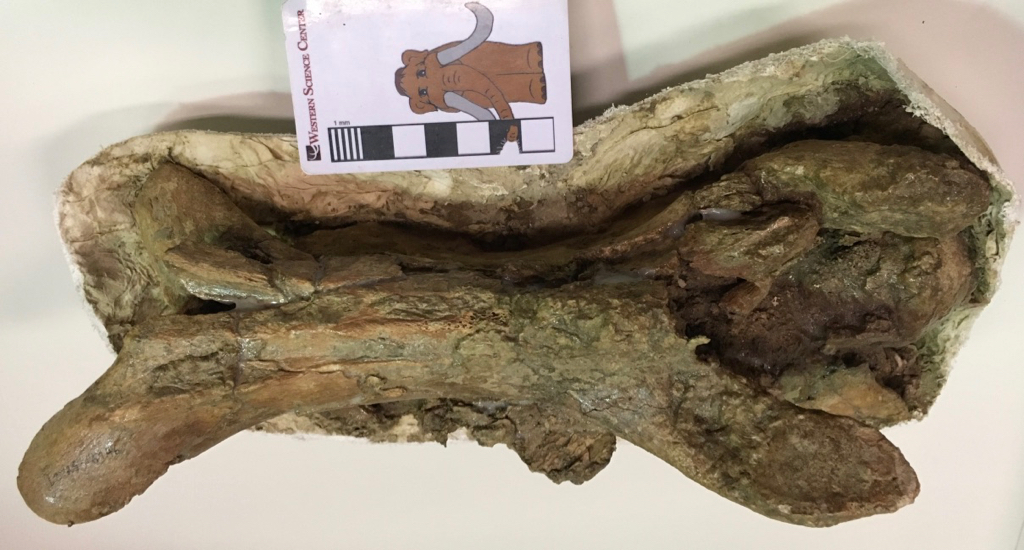 I'm endlessly fascinated by the strange skeleton of the western camel, Camelops hesternus. Camelops was a massive animal, and many of its bones were so large they can easily be mistaken for those from a bison. Yet other parts of the skeleton are almost delicate.The long, slender bone shown above is a Camelops neck vertebra. Camelops had a long neck, but like almost all other mammals the neck had only seven vertebrae, so each vertebra had to be pretty elongate. (Most non-mammals with long necks have lots of shorter vertebrae, although there were exceptions.) The vertebra is shown in dorsal view (from above), and the front is to the right. The yoke-shaped structures at each end at the prezygopophyses (at the front) and the postzygopophyses (at the back), which articulated respectively with the zygopophyses of the preceding and following vertebrae.
I'm endlessly fascinated by the strange skeleton of the western camel, Camelops hesternus. Camelops was a massive animal, and many of its bones were so large they can easily be mistaken for those from a bison. Yet other parts of the skeleton are almost delicate.The long, slender bone shown above is a Camelops neck vertebra. Camelops had a long neck, but like almost all other mammals the neck had only seven vertebrae, so each vertebra had to be pretty elongate. (Most non-mammals with long necks have lots of shorter vertebrae, although there were exceptions.) The vertebra is shown in dorsal view (from above), and the front is to the right. The yoke-shaped structures at each end at the prezygopophyses (at the front) and the postzygopophyses (at the back), which articulated respectively with the zygopophyses of the preceding and following vertebrae.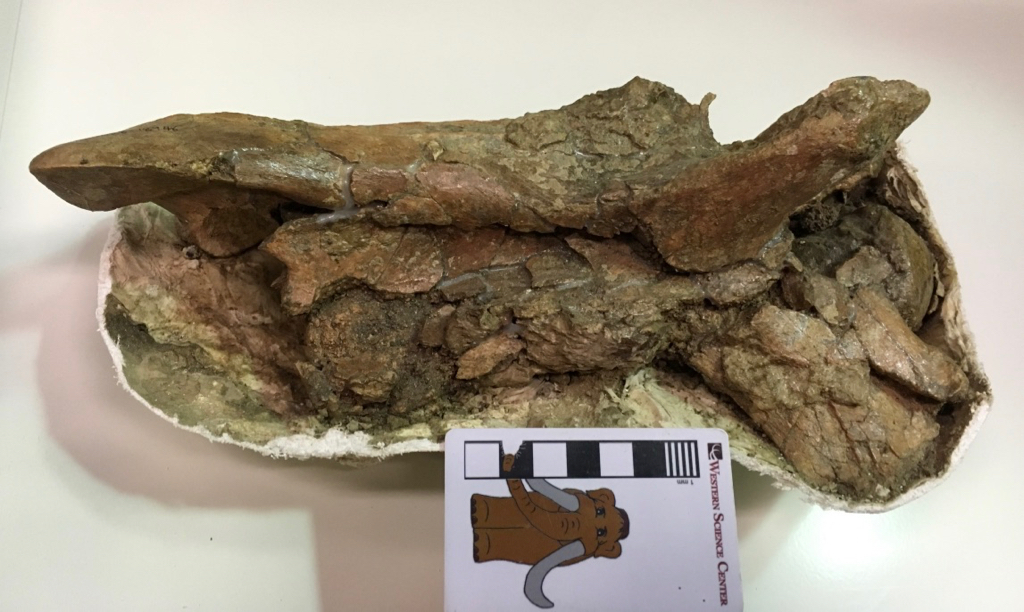 Looking at the right side, the ball joint at the front of the vertebral centrum is visible on the right. This corresponded to a socket on the back of the preceding vertebra, but didn't actually fit tightly into the socket as a large cartilage pad separated them in life. The large bony projection on the lower right is the right anteroventral costellar process. These processes provided attachment areas from some of the neck muscles, and are uniquely large in the camels.This particular vertebra was collected in 1999 near the East Dam of Diamond Valley Lake, and is probably around 50,000 years old.
Looking at the right side, the ball joint at the front of the vertebral centrum is visible on the right. This corresponded to a socket on the back of the preceding vertebra, but didn't actually fit tightly into the socket as a large cartilage pad separated them in life. The large bony projection on the lower right is the right anteroventral costellar process. These processes provided attachment areas from some of the neck muscles, and are uniquely large in the camels.This particular vertebra was collected in 1999 near the East Dam of Diamond Valley Lake, and is probably around 50,000 years old.
Fossil Friday - Camelops jaw
 This may look a bit like a zombie hand reaching from the grave in some B-horror movie (at least it does to me). In fact, it's a fossil that's quite a bit more interesting and less dangerous than a zombie hand.This is part of the lower jaw of the western camel Camelops hesternus, a fairly common species across western North America in the Late Pleistocene. This is the chin, technically called the mandibular symphysis, seen from underneath (ventral view). The forked structure on the left is behind the symphysis, where the left and right dentary bones separate to form each side of the lower jaw. The "fingers" on the right are the incisor teeth.Here's the dorsal view:
This may look a bit like a zombie hand reaching from the grave in some B-horror movie (at least it does to me). In fact, it's a fossil that's quite a bit more interesting and less dangerous than a zombie hand.This is part of the lower jaw of the western camel Camelops hesternus, a fairly common species across western North America in the Late Pleistocene. This is the chin, technically called the mandibular symphysis, seen from underneath (ventral view). The forked structure on the left is behind the symphysis, where the left and right dentary bones separate to form each side of the lower jaw. The "fingers" on the right are the incisor teeth.Here's the dorsal view: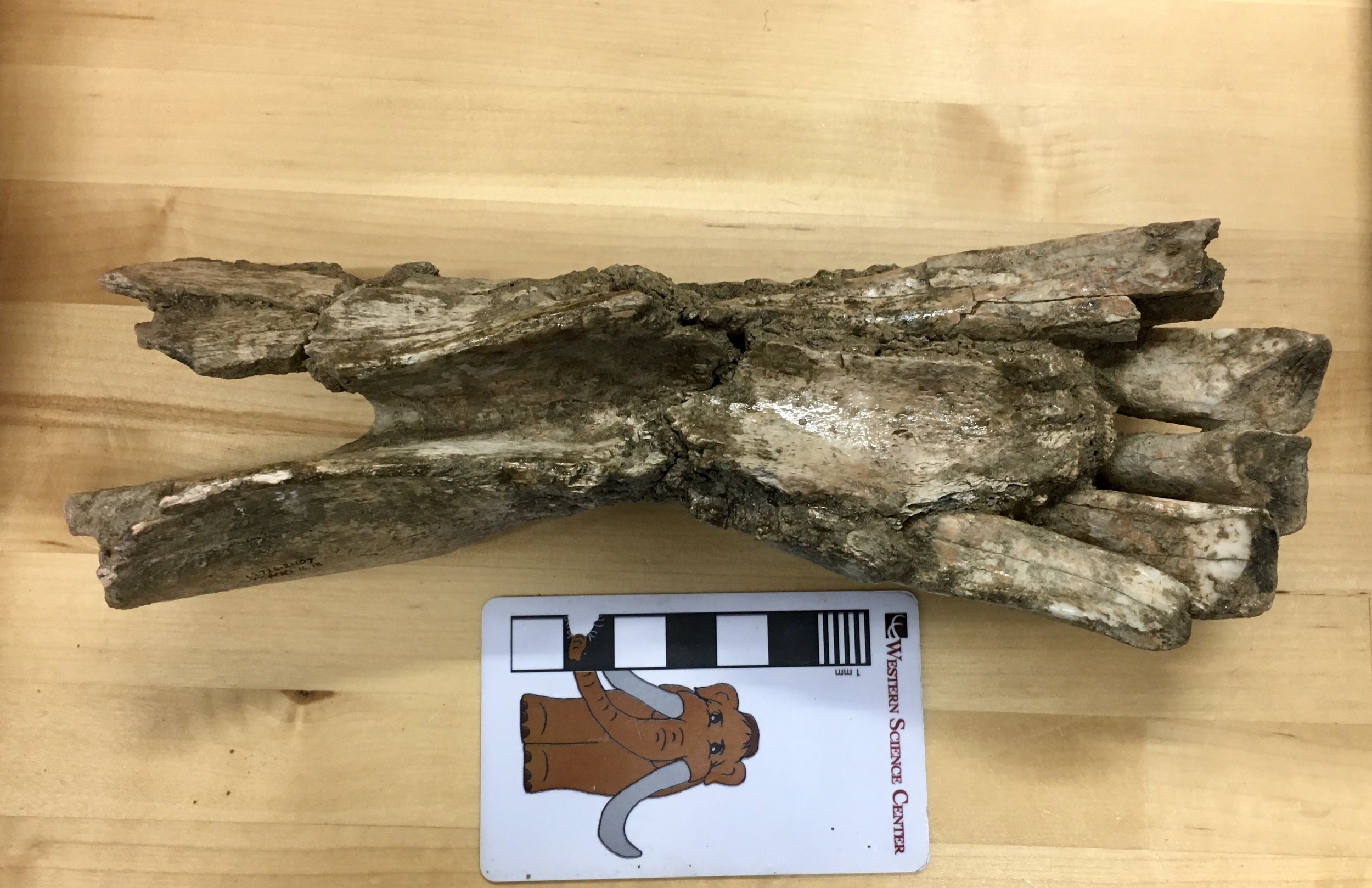 The incisors are more clearly visible in this view. Camels have three lower incisors on each side of the lower jaw; this specimen preserves all three on the right side, but only the first two on the left.Below is a lateral view of the right side:
The incisors are more clearly visible in this view. Camels have three lower incisors on each side of the lower jaw; this specimen preserves all three on the right side, but only the first two on the left.Below is a lateral view of the right side: Because the bone is damaged on this side the entire length of the 3rd incisor is visible (minus whatever part of the tooth wore away before the camel died). Camels eat a tough, abrasive diet that is hard on teeth; camels compensate for this in part by having really long incisors that take a long time to wear down (the technical term - because OF COURSE there's a technical term! - is hypsodonty).We have more of this jaw, and it appears that there are no lower canine teeth. Since this is an adult animal, I suspect that it represents a female, since male camels (including Camelops) tend to have fairly prominent upper and lower canines. However, I need to do a little more research on Camelops to confirm that it displays this type of sexual dimorphism.Here's a close-up of the occlusal surfaces of the teeth:
Because the bone is damaged on this side the entire length of the 3rd incisor is visible (minus whatever part of the tooth wore away before the camel died). Camels eat a tough, abrasive diet that is hard on teeth; camels compensate for this in part by having really long incisors that take a long time to wear down (the technical term - because OF COURSE there's a technical term! - is hypsodonty).We have more of this jaw, and it appears that there are no lower canine teeth. Since this is an adult animal, I suspect that it represents a female, since male camels (including Camelops) tend to have fairly prominent upper and lower canines. However, I need to do a little more research on Camelops to confirm that it displays this type of sexual dimorphism.Here's a close-up of the occlusal surfaces of the teeth: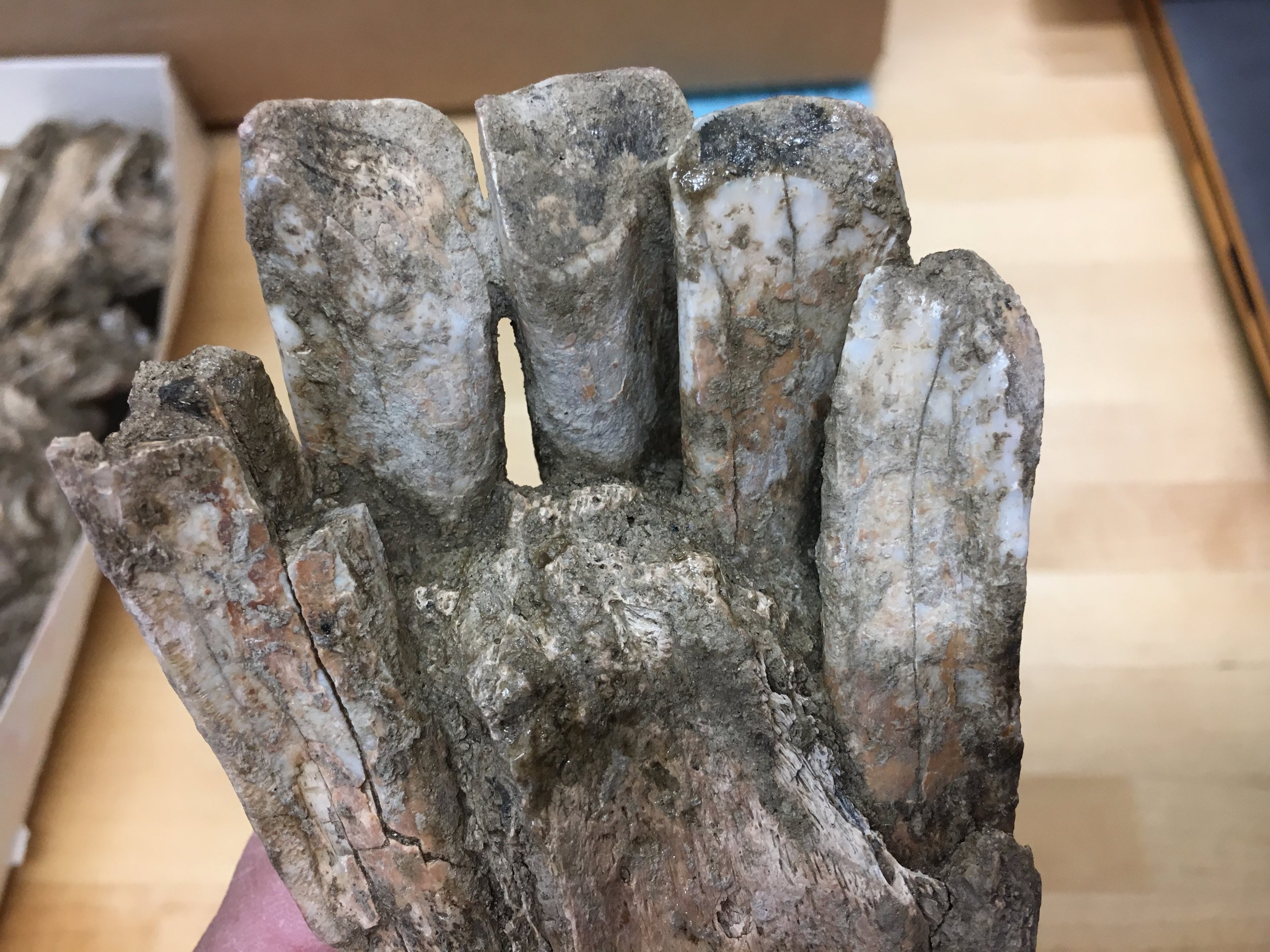 An interesting feature is that each of the three right incisors has a different shape and cross section. Using this specimen as a reference, and assuming there's not a huge amount of individual variation, we should be able to identify the exact position of isolated Camelops incisors from other specimens.We're working on making a 3D photogrammetric model of this specimen, which will be posted on our Sketchfab account in a few weeks.
An interesting feature is that each of the three right incisors has a different shape and cross section. Using this specimen as a reference, and assuming there's not a huge amount of individual variation, we should be able to identify the exact position of isolated Camelops incisors from other specimens.We're working on making a 3D photogrammetric model of this specimen, which will be posted on our Sketchfab account in a few weeks.
Mastodons and pumpkins
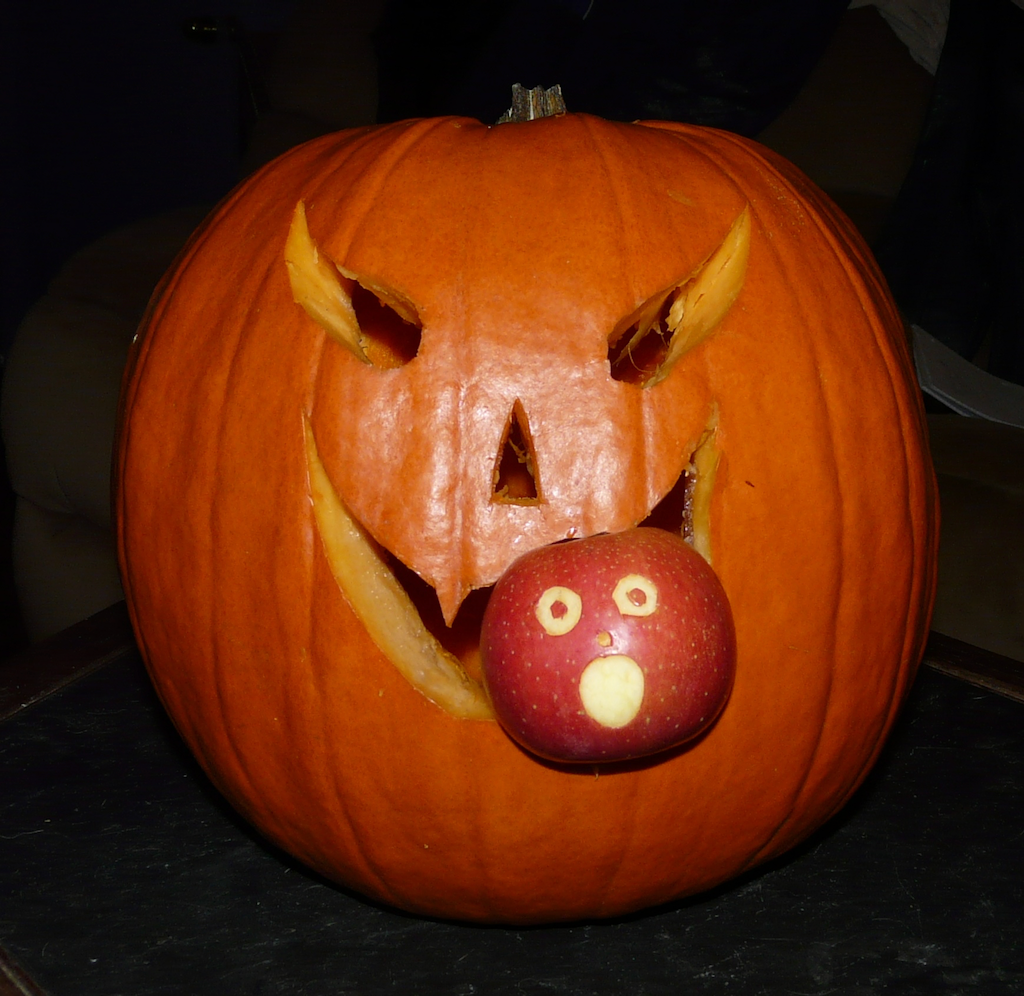 Pumpkins are an interesting fruit. Curcurbita pepo is one of several domesticated species of the genus Curcurbita, vines that are native to the Americas. Curcurbita is a ecologically diverse genus, with some species needing a continuous water supply while others can live in arid conditions, so it is found natively in a variety of habitats. The fruits, which are technically berries, generally have a thick rind with a softer interior where the seeds are located. In most species the rinds are bitter, but the interior is often more palatable and rich in nutrients. As a result it became one of the first domesticated plants in North America more than 8,000 years ago.With large, nutritious fruits, we can be confident that wild Curcurbita were being eaten by more than just humans. In 2006 Lee Newsom and Matthew Mihlbachler published a detailed report about an American mastodon dung deposit in northern Florida. The vast majority of the dung consisted of small cypress twigs, chopped up and stripped of bark, but there were other plant remains from at least 57 species. Among their samples were 156 Curcurbita seeds, showing that this was a popular item on the mastodon menu. Using the Newsom and Mihlbachler paper as a guide, a few years ago we made a simulated piece of mastodon dung for exhibit at WSC, including numerous pumpkin and squash seeds:
Pumpkins are an interesting fruit. Curcurbita pepo is one of several domesticated species of the genus Curcurbita, vines that are native to the Americas. Curcurbita is a ecologically diverse genus, with some species needing a continuous water supply while others can live in arid conditions, so it is found natively in a variety of habitats. The fruits, which are technically berries, generally have a thick rind with a softer interior where the seeds are located. In most species the rinds are bitter, but the interior is often more palatable and rich in nutrients. As a result it became one of the first domesticated plants in North America more than 8,000 years ago.With large, nutritious fruits, we can be confident that wild Curcurbita were being eaten by more than just humans. In 2006 Lee Newsom and Matthew Mihlbachler published a detailed report about an American mastodon dung deposit in northern Florida. The vast majority of the dung consisted of small cypress twigs, chopped up and stripped of bark, but there were other plant remains from at least 57 species. Among their samples were 156 Curcurbita seeds, showing that this was a popular item on the mastodon menu. Using the Newsom and Mihlbachler paper as a guide, a few years ago we made a simulated piece of mastodon dung for exhibit at WSC, including numerous pumpkin and squash seeds: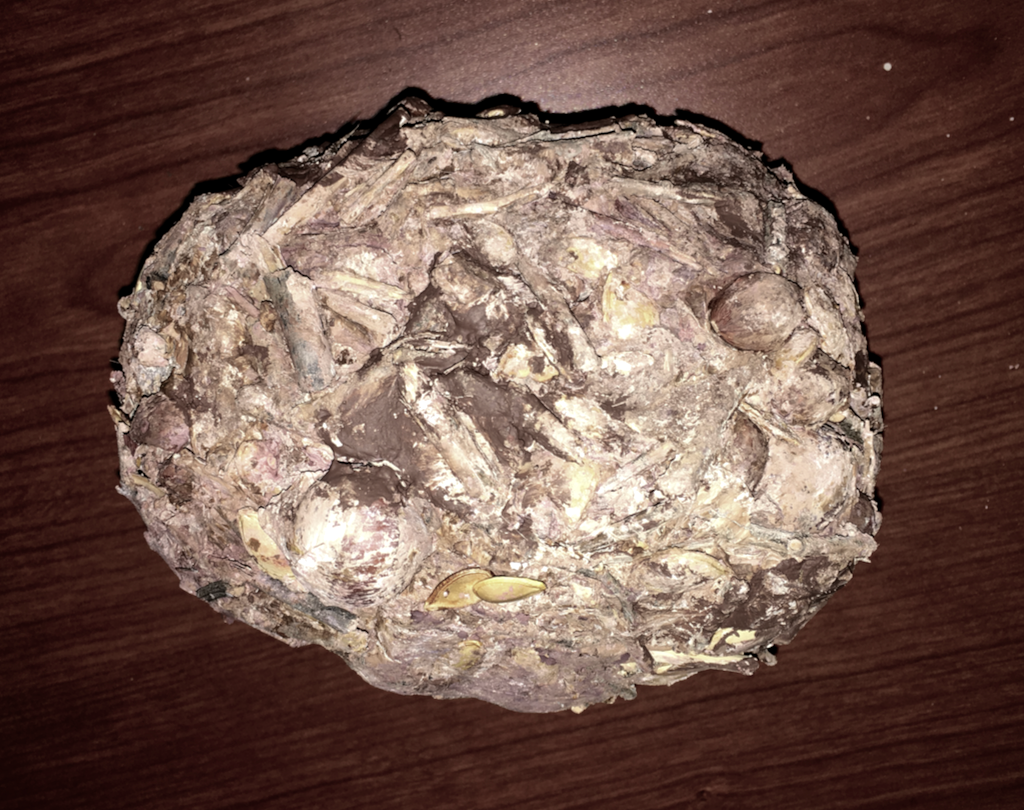 Newsom and Mihlbachler also noted that, while Curcurbita seeds were relatively common in their sample, rind fragments were almost completely absent. It seems that mastodons may have disliked the bitter rinds just like we do, and broken the gourds open to get at the interior. Captive elephants that are fed pumpkins seem to have discovered the same trick:[youtube https://www.youtube.com/watch?v=2CzXH2Eg1hw&w=560&h=315]So far no Pacific mastodon coprolites have been identified, but hopefully one day we'll be able so say as much about their dietary habits.Reference:Lee Newsom and Matthew C. Mihlbachler, 2006. Mastodon (Mammut americanum) diet and foraging patterns based on analysis of dung deposits. Chapter 10 in S. David Webb (ed.), First Floridians and Last Mastodons: The Page-Ladson Site in the Aucilla River, Springer, p. 263-331.
Newsom and Mihlbachler also noted that, while Curcurbita seeds were relatively common in their sample, rind fragments were almost completely absent. It seems that mastodons may have disliked the bitter rinds just like we do, and broken the gourds open to get at the interior. Captive elephants that are fed pumpkins seem to have discovered the same trick:[youtube https://www.youtube.com/watch?v=2CzXH2Eg1hw&w=560&h=315]So far no Pacific mastodon coprolites have been identified, but hopefully one day we'll be able so say as much about their dietary habits.Reference:Lee Newsom and Matthew C. Mihlbachler, 2006. Mastodon (Mammut americanum) diet and foraging patterns based on analysis of dung deposits. Chapter 10 in S. David Webb (ed.), First Floridians and Last Mastodons: The Page-Ladson Site in the Aucilla River, Springer, p. 263-331.
Fossil Friday - ammonites
 Among the most abundant and aesthetically varied fossils are the ammonites. These shelled marine mollusks are related to living cephalopods such as octopus, squid, and cuttlefish. With a fossil record that spans the globe and the Devonian through Cretaceous periods (408 - 66 million years ago), ammonites were very successful animals, evolving into a range of sizes, habitats, and shell morphologies. Their long evolutionary history ended 66 million years ago, in the same mass extinction that eliminated non-avian dinosaurs and many other animals and plants.Ammonites are very useful for determining the age of the rocks in which they occur, with different shell morphologies occurring only in certain slices of time. For example, in previous posts, I have discussed Cretaceous dinosaurs from New Mexico. Although we don't yet know the exact age of the Menefee Formation, the rock layer in which the dinosaur fossils occur, we do know that they must be older than 78.5 million years because the rocks right above the Menefee contain an ammonite called Baculites perplexus, which is tied to an age of about 78.5 million years old.In today's photo are four fossil ammonite shells, each representing a different species. These shells were donated to the Western Science Center and come from Tarrant County, Texas. Dating to around 105 million years ago, these ammonites lived in the early history of a shallow saltwater sea that covered much of the interior of North America during the Late Cretaceous. You can see these four ammonites and the fossils of many other prehistoric sea creatures in the Western Science Center's new temporary exhibit, "Life in the Ancient Seas".
Among the most abundant and aesthetically varied fossils are the ammonites. These shelled marine mollusks are related to living cephalopods such as octopus, squid, and cuttlefish. With a fossil record that spans the globe and the Devonian through Cretaceous periods (408 - 66 million years ago), ammonites were very successful animals, evolving into a range of sizes, habitats, and shell morphologies. Their long evolutionary history ended 66 million years ago, in the same mass extinction that eliminated non-avian dinosaurs and many other animals and plants.Ammonites are very useful for determining the age of the rocks in which they occur, with different shell morphologies occurring only in certain slices of time. For example, in previous posts, I have discussed Cretaceous dinosaurs from New Mexico. Although we don't yet know the exact age of the Menefee Formation, the rock layer in which the dinosaur fossils occur, we do know that they must be older than 78.5 million years because the rocks right above the Menefee contain an ammonite called Baculites perplexus, which is tied to an age of about 78.5 million years old.In today's photo are four fossil ammonite shells, each representing a different species. These shells were donated to the Western Science Center and come from Tarrant County, Texas. Dating to around 105 million years ago, these ammonites lived in the early history of a shallow saltwater sea that covered much of the interior of North America during the Late Cretaceous. You can see these four ammonites and the fossils of many other prehistoric sea creatures in the Western Science Center's new temporary exhibit, "Life in the Ancient Seas".
Fossil Friday - Foerestephyllum
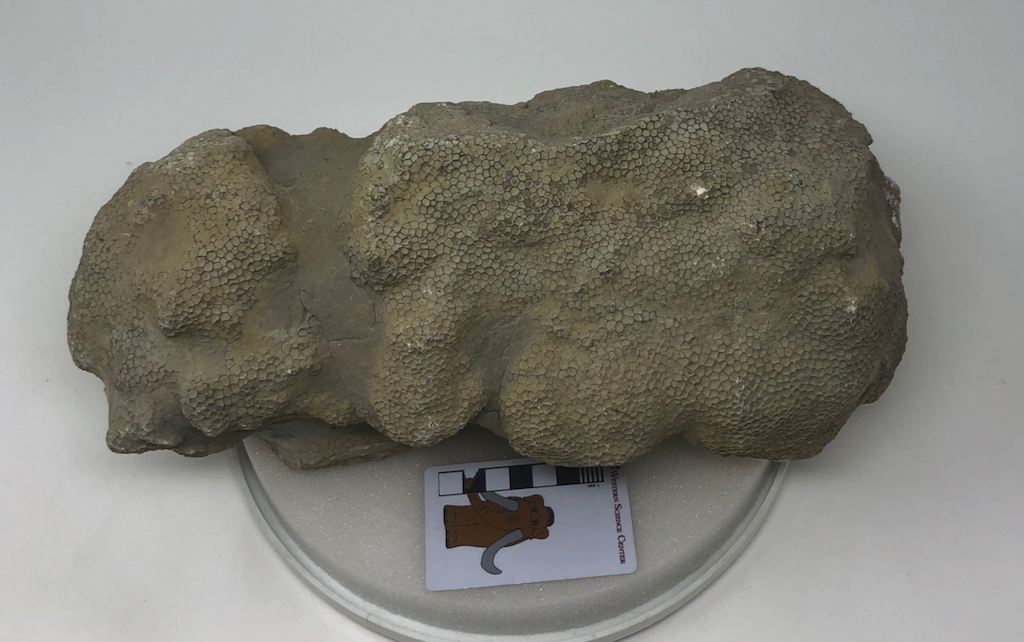 Corals are such an iconic part of the modern ocean, it's easy to overlook the fact that they didn't become widespread until the Ordovician Period, 4 billion years after the Earth formed and some 30 million years after the Cambrian Explosion.The coral shown above is Foerstephyllum, and example of a tabulate coral. The Tabulata are one of the two common types of fossil corals in the Paleozoic Era, along with the Rugosa. Of course, an important reason these groups are common as fossils is because they made large calcite structures that preserve very well. At least in the modern ocean, there are many soft-bodied corals that would be much less likely to fossilize, and that may have been the case in the past as well.This Foerstephyllum head comes from the Drakes Formation near Bardstown, Kentucky. There is a layer within this unit that is made mostly of large coral heads:
Corals are such an iconic part of the modern ocean, it's easy to overlook the fact that they didn't become widespread until the Ordovician Period, 4 billion years after the Earth formed and some 30 million years after the Cambrian Explosion.The coral shown above is Foerstephyllum, and example of a tabulate coral. The Tabulata are one of the two common types of fossil corals in the Paleozoic Era, along with the Rugosa. Of course, an important reason these groups are common as fossils is because they made large calcite structures that preserve very well. At least in the modern ocean, there are many soft-bodied corals that would be much less likely to fossilize, and that may have been the case in the past as well.This Foerstephyllum head comes from the Drakes Formation near Bardstown, Kentucky. There is a layer within this unit that is made mostly of large coral heads: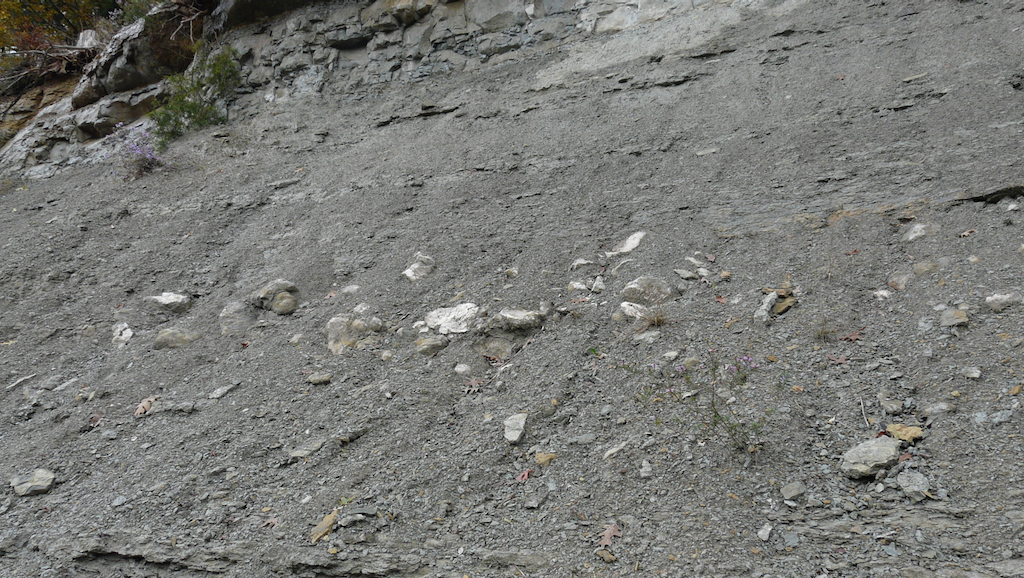 This bed is close to the top of the Ordovician; in fact, the massive rocks visible in the upper left corner are Silurian, although I think there is an unconformity between them.Tabulate corals remained as significant reef-builders up to the end of the Paleozoic Era. They went extinct, along with the rugose corals and about 90% or more of all marine species, in the devastating mass extinction at the end of the Permian Period.This specimen of Foerstephyllum is currently on display at the Western Science Center in the "Life in the Ancient Seas" exhibit, and a 3D model is available for viewing and download on SketchFab at https://skfb.ly/6NtRI.
This bed is close to the top of the Ordovician; in fact, the massive rocks visible in the upper left corner are Silurian, although I think there is an unconformity between them.Tabulate corals remained as significant reef-builders up to the end of the Paleozoic Era. They went extinct, along with the rugose corals and about 90% or more of all marine species, in the devastating mass extinction at the end of the Permian Period.This specimen of Foerstephyllum is currently on display at the Western Science Center in the "Life in the Ancient Seas" exhibit, and a 3D model is available for viewing and download on SketchFab at https://skfb.ly/6NtRI.
Fossil Friday - bourbon and geology
2011-02-20a
2011-02-20b
2011-02-20c
2011-02-20d
2011-02-20e
2011-02-20f
2011-02-20g
2011-02-20h
2011-02-20i
In a few weeks we'll be opening our new exhibit at WSC, "Life in the Ancient Seas", which will include a fair number of specimens from Ordovician rocks in the midwest. In recognition of that event, I'm reposting this post, originally published on my old blog "Updates from the Paleontology Lab" in 2011.A signature product of the southeastern United States, and one with which my family has had a generations-long relationship (at least as consumers), is bourbon whiskey. Bourbon is produced through a rather complex process involving the fermentation of corn and grain, which is then double- or triple-distilled and finally aged in charred white oak barrels; the general guidelines defining bourbon are actually formalized in U. S. law. Approximately 90% of all the bourbon produced in the U.S. comes from the Bluegrass region of northern Kentucky, so Brett and I spent the weekend there with our friends Andy and Shannon exploring the Bourbon Trail, visiting six distilleries in two days (Makers Mark Distillery’s aging warehouse shown above). But what makes this region so good for producing bourbon?It’s all in the water. Bourbon production is a water-intensive process, with water figuring heavily in every stage of production (Fryar, 2009). A steady supply of low-temperature water is important for the distilling process, and in early (pre-refrigeration) days that meant natural springs. It helps the fermentation process if the water has a somewhat high pH, as bacteria involved in fermentation respond well to these conditions. A high iron content in the water is bad, as it adversely affects both color and taste. But this simply moves our question back another step; why does northern Kentucky have water with these characteristics?To answer that, we have to go back to the Ordovician. The Inner Bluegrass region is underlain mainly by lower and middle Ordovician rocks, while the Outer Bluegrass region is mostly underlain by late Ordovician and Silurian rocks (as shown on this Google Earth/USGS map overlay):During the Ordovician Kentucky sat in the tropics, and this area was part of a vast carbonate platform covered by a shallow inland sea. The evidence can be seen in every roadcut in the area (such as the one shown above, south of Lexington), in the form of huge numbers of marine invertebrate fossils. The fauna is dominated by brachiopods and bryozoans, with large numbers or rugose and tabulate corals, crinoids, trilobites, mollusks, and a variety of less common critters:The rocks containing these fossils are almost entirely limestone, mostly made of fragments of the shells. This limestone is very porous, and like all limestones is composed primarily of carbonate minerals, especially calcite (CaCO3). Calcite is quite soluble, especially in acidic water, and limestone areas are often riddled with caves and sinkholes, known to geologists as karst topography. The surface expression of karst topography is clear on topographic maps in the form of numerous ponds and depressions, as in this region just east of Bardstown (USGS Bardstown 7.5’ Quadrangle):Karst topography results in lots of groundwater flow, producing the springs and natural wells needed to provide a reliable, constant-temperature water supply.High dissolved carbonate concentrations also raise the pH of water (i.e. make it less acidic). As mentioned above, this is good for fermentation, which is the first step in bourbon production, as seen in the fermentation vats at Four Roses Distillery:Iron is not a component of the shells of marine organisms, so under ideal conditions carbonates should be poor in iron. However, clastic sediments derived from erosion on continents are iron-rich. Since carbonates are usually deposited in fairly shallow water, there is usually a nearby source of terrestrial sediment, so the limestones often have a fairly large amount of iron. But the Ordovician carbonate platform of which Kentucky was a part was vast, fully 500 miles across. In the earliest Ordovician the coast of North America was a passive margin, so with sea level high there was little or no dry land anywhere near Kentucky (map from Ron Blakey’s Paleogeography and Geologic Evolution of North America website).By the late Ordovician, subduction off the coast of proto-North America had resulted in the formation of arc volcanoes. With no significant terrestrial plants, erosion of these mountains was rapid, and they began dumping lots of iron-rich sediment initially into the Appalachian Trough, and eventually onto the carbonate platform. But all this was happening several hundred miles from Kentucky, so even by the end of the Ordovician and into the Silurian there was still no significant terrestrial sediment being deposited in the Bluegrass region (again, map from Ron Blakey’s Paleogeography and Geologic Evolution of North America website):As European settlers moved west over the Appalachians, the Bluegrass region of Kentucky was the first place these rocks were encountered. While Ordovician limestones are common to the north and west of the Bluegrass region, a larger percentage of clastic sediments results in a higher iron content in the groundwater. The unique conditions experienced by the Bluegrass region 450 million years ago resulted in the deposition of thick sections of relatively iron-free limestones, providing the abundant, clean groundwater needed for bourbon production.Reference: Fryar, A. E., 2009. Springs and the origin of bourbon. Groundwater 47:605-610.
Fossil Friday - sunset clam
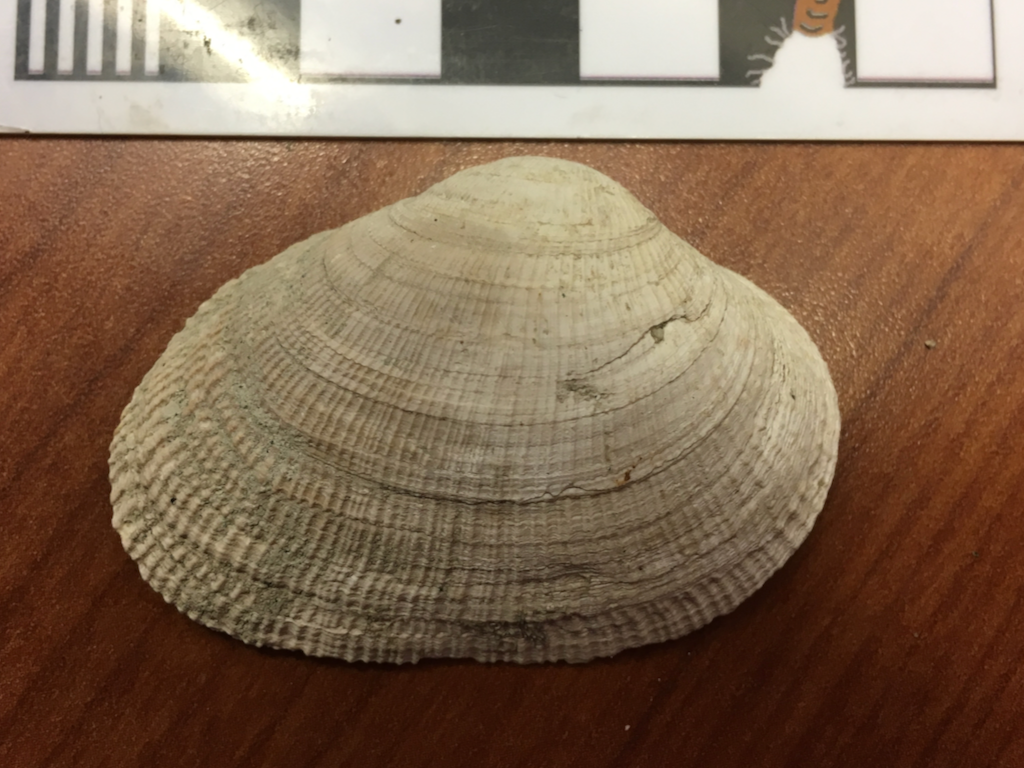 At the end of this month WSC is opening a new exhibit, "Life in the Ancient Seas". A big portion of the staff's efforts are currently focused on getting this ready, including writing labels for individual specimens; this may be the largest exhibit we've ever done in terms of shear specimen count! But sometimes these labels can be difficult to write, as the information is often obscure.This shell comes from Pliocene deposits near Chuckatuck, Virginia, specifically the Moore House Member of the Yorktown Formation. We have a small collection from this site at WSC, numbering perhaps 200-300 shells. Ten of them are from this species. This is a site I'm quite familiar with; I collected there numerous times when I worked at the Virginia Museum of Natural History, and in fact Brett collected this specimen on a field trip I ran there about 10 years ago. My first job at VMNH was sorting fossil mollusks from this and other localities, so while I'm not an expert on Pliocene mollusks I'm probably more familiar with them than is typical for a vertebrate paleontologist.This shell had me stumped, though. At first I thought it was from the genus Striarca, like the example below from the Marine Life Encyclopedia:
At the end of this month WSC is opening a new exhibit, "Life in the Ancient Seas". A big portion of the staff's efforts are currently focused on getting this ready, including writing labels for individual specimens; this may be the largest exhibit we've ever done in terms of shear specimen count! But sometimes these labels can be difficult to write, as the information is often obscure.This shell comes from Pliocene deposits near Chuckatuck, Virginia, specifically the Moore House Member of the Yorktown Formation. We have a small collection from this site at WSC, numbering perhaps 200-300 shells. Ten of them are from this species. This is a site I'm quite familiar with; I collected there numerous times when I worked at the Virginia Museum of Natural History, and in fact Brett collected this specimen on a field trip I ran there about 10 years ago. My first job at VMNH was sorting fossil mollusks from this and other localities, so while I'm not an expert on Pliocene mollusks I'm probably more familiar with them than is typical for a vertebrate paleontologist.This shell had me stumped, though. At first I thought it was from the genus Striarca, like the example below from the Marine Life Encyclopedia: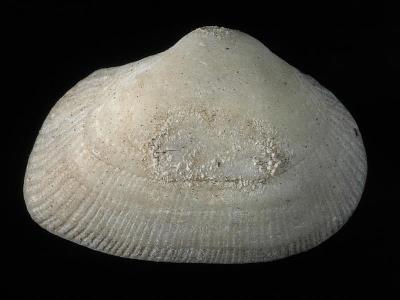 But a quick look at the other side of the shell ruled this out. Striarca is a member of the order Arcoidea, which have very distinctive hinges. But the Chuckatuck shell had a different hinge, that looked to me like a member of the Veneroida. Below, the first image is Striarca (from WoRMS), while the second is the Chuckatuck shell:
But a quick look at the other side of the shell ruled this out. Striarca is a member of the order Arcoidea, which have very distinctive hinges. But the Chuckatuck shell had a different hinge, that looked to me like a member of the Veneroida. Below, the first image is Striarca (from WoRMS), while the second is the Chuckatuck shell: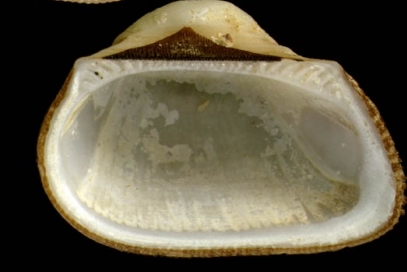
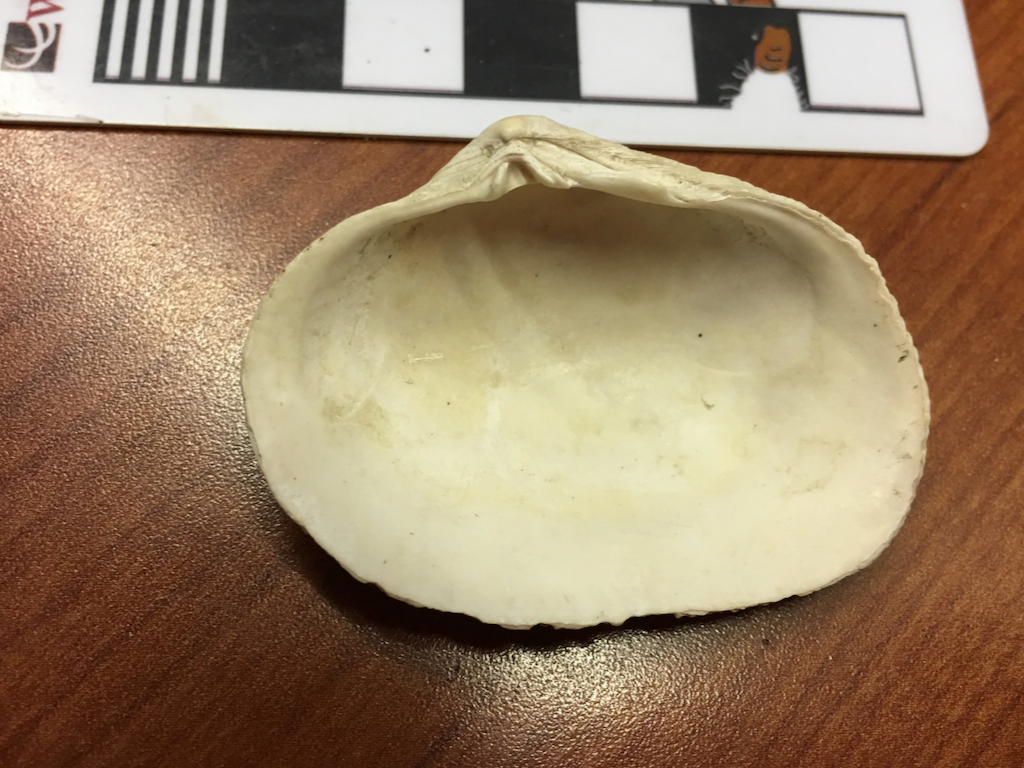 The problem was that none of the references I had at hand seemed to include a veneroid that matched both the size and appearance of this shell. Image searches online were not producing much of use, so I went to Twitter. Within a day or so I got a response:
The problem was that none of the references I had at hand seemed to include a veneroid that matched both the size and appearance of this shell. Image searches online were not producing much of use, so I went to Twitter. Within a day or so I got a response: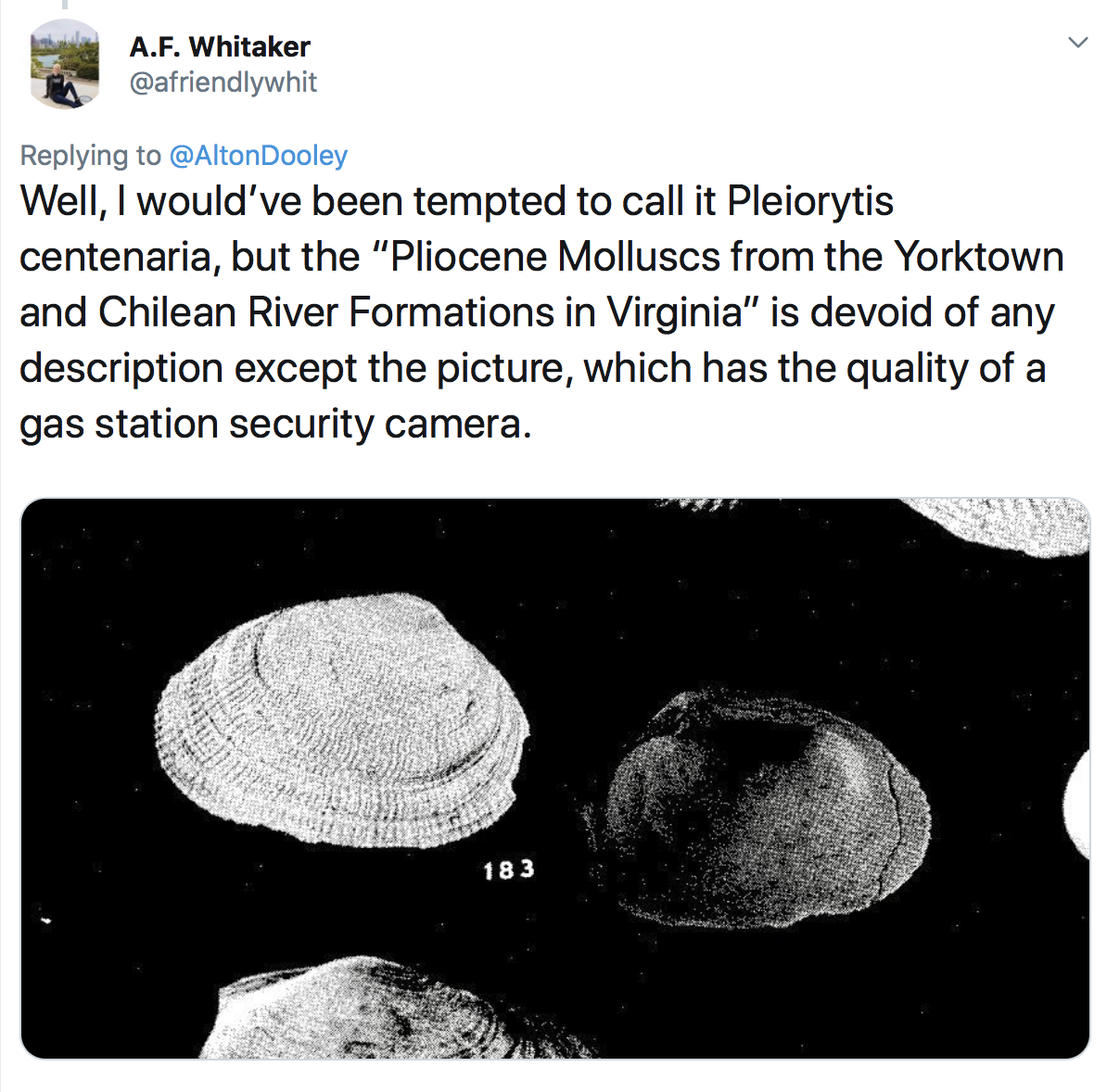 Unfortunately searches for Pleiorytis centenaria didn't turn up much. But then I received another Twitter response:
Unfortunately searches for Pleiorytis centenaria didn't turn up much. But then I received another Twitter response: So that solved it! Asaphis is a veneroid, a member of a family known as the sunset clams. There's even a photo online of Asaphis centenaria from the Pliocene Tamiami Formation of Florida:
So that solved it! Asaphis is a veneroid, a member of a family known as the sunset clams. There's even a photo online of Asaphis centenaria from the Pliocene Tamiami Formation of Florida: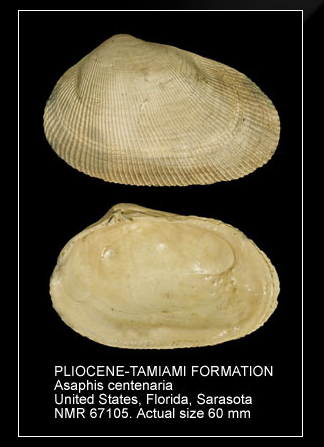 So, mystery solved! And this allows us to display the particular specimen that I wanted to include in the exhibit:
So, mystery solved! And this allows us to display the particular specimen that I wanted to include in the exhibit: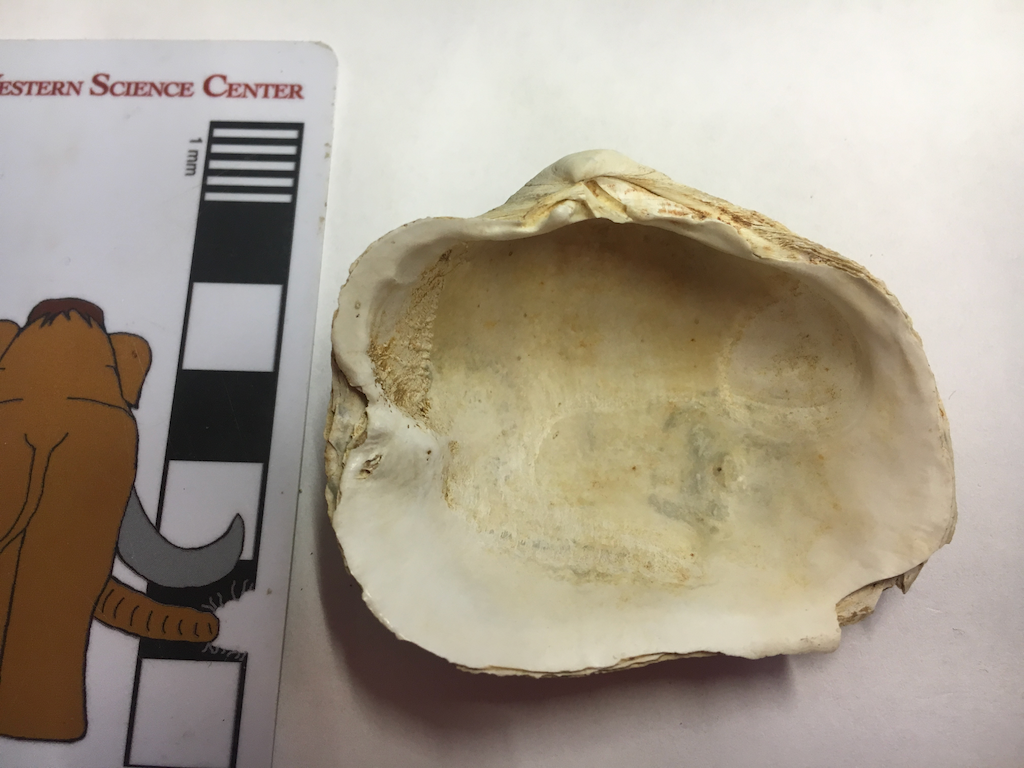 Notice the odd wrinkle on the left side of the shell. While Asaphis and other clams are sometimes misshapen because of where they happen to be growing, I don't think that's what happened here, because I've seen similar wrinkles in shells from mobile taxa, such as scallops. This looks like the clam suffered a non-fatal injury at some point. Perhaps a crab or some other predator tried to crack open the shell. The attack was unsuccessful, but it did some damage and the crab repaired the damage by depositing new shell layers over the injury as it grew. I love features like this, traces that give us glimpses into the daily lives of organisms that happened millions of years in the past.Thanks to @afriendlywhit and @paleomollusk for their help with this identification. "Life in the Ancient Seas" opens to the public on August 31.
Notice the odd wrinkle on the left side of the shell. While Asaphis and other clams are sometimes misshapen because of where they happen to be growing, I don't think that's what happened here, because I've seen similar wrinkles in shells from mobile taxa, such as scallops. This looks like the clam suffered a non-fatal injury at some point. Perhaps a crab or some other predator tried to crack open the shell. The attack was unsuccessful, but it did some damage and the crab repaired the damage by depositing new shell layers over the injury as it grew. I love features like this, traces that give us glimpses into the daily lives of organisms that happened millions of years in the past.Thanks to @afriendlywhit and @paleomollusk for their help with this identification. "Life in the Ancient Seas" opens to the public on August 31.
Fossil Friday - ceratopsid ilium
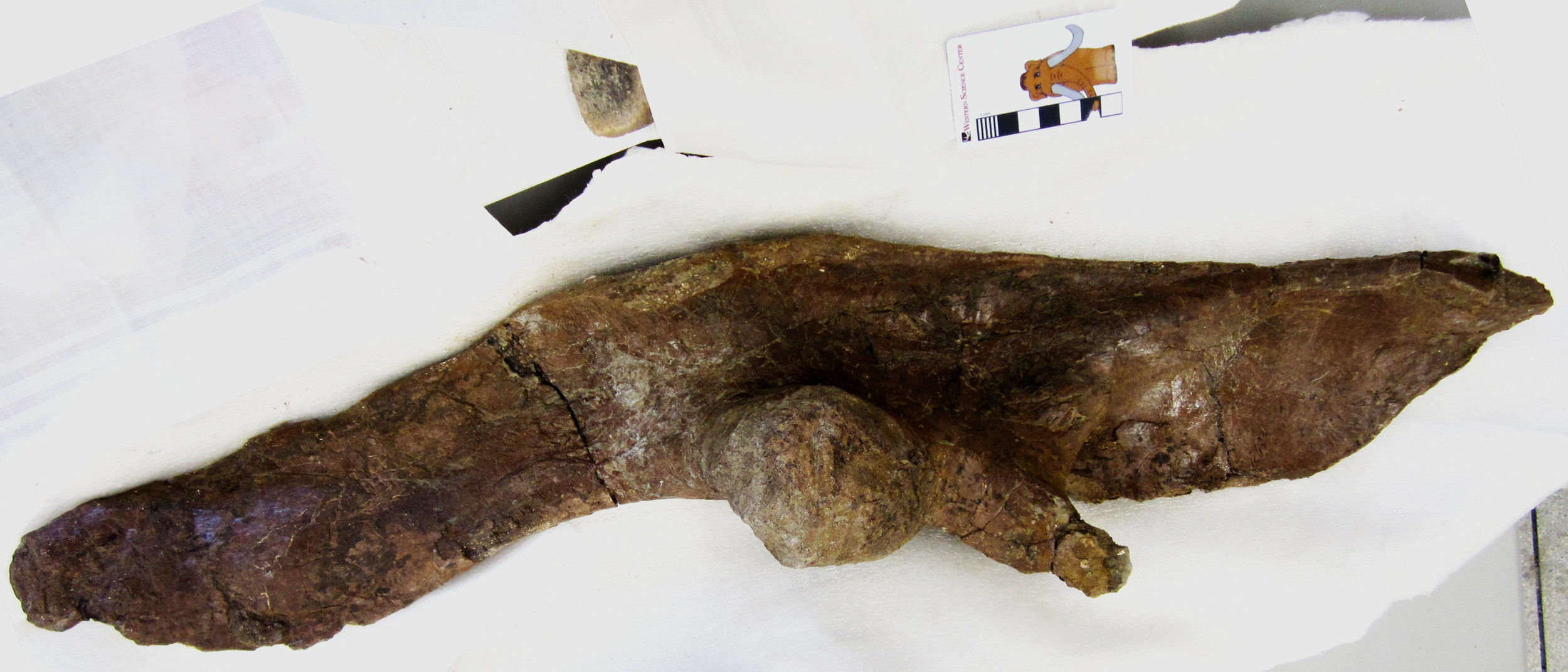 On May 17, I posted a photo of the ilium of a ceratopsid dinosaur that we collected in the Upper Cretaceous Menefee Formation of New Mexico. At the time, only the medial surface of the bone was visible; however, WSC volunteer Joe Reavis has been working hard and has now prepped the lateral surface as well. On May 17, I identified the bone as a left ilium, but now that I can see the whole thing, I can say that it's actually a right ilium.This beautifully-preserved ilium is part of an incomplete skeleton that also includes vertebrae and ribs from the torso, as well as the sacrum, the series of fused vertebrae to which this ilium would have attached. Ceratopsids, the great horned dinosaurs such as Triceratops, were very abundant and diverse in western North America during the Late Cretaceous; our specimen is around 79 million years old, and we can't yet determine what species it represents. This skeleton was collected in 2016-2018 by staff and volunteers from the Western Science Center, Zuni Dinosaur Institute for Geosciences, and Southwest Paleontological Society.Post by Curator Dr. Andrew McDonald
On May 17, I posted a photo of the ilium of a ceratopsid dinosaur that we collected in the Upper Cretaceous Menefee Formation of New Mexico. At the time, only the medial surface of the bone was visible; however, WSC volunteer Joe Reavis has been working hard and has now prepped the lateral surface as well. On May 17, I identified the bone as a left ilium, but now that I can see the whole thing, I can say that it's actually a right ilium.This beautifully-preserved ilium is part of an incomplete skeleton that also includes vertebrae and ribs from the torso, as well as the sacrum, the series of fused vertebrae to which this ilium would have attached. Ceratopsids, the great horned dinosaurs such as Triceratops, were very abundant and diverse in western North America during the Late Cretaceous; our specimen is around 79 million years old, and we can't yet determine what species it represents. This skeleton was collected in 2016-2018 by staff and volunteers from the Western Science Center, Zuni Dinosaur Institute for Geosciences, and Southwest Paleontological Society.Post by Curator Dr. Andrew McDonald
Fossil Friday - traces on a mammoth rib
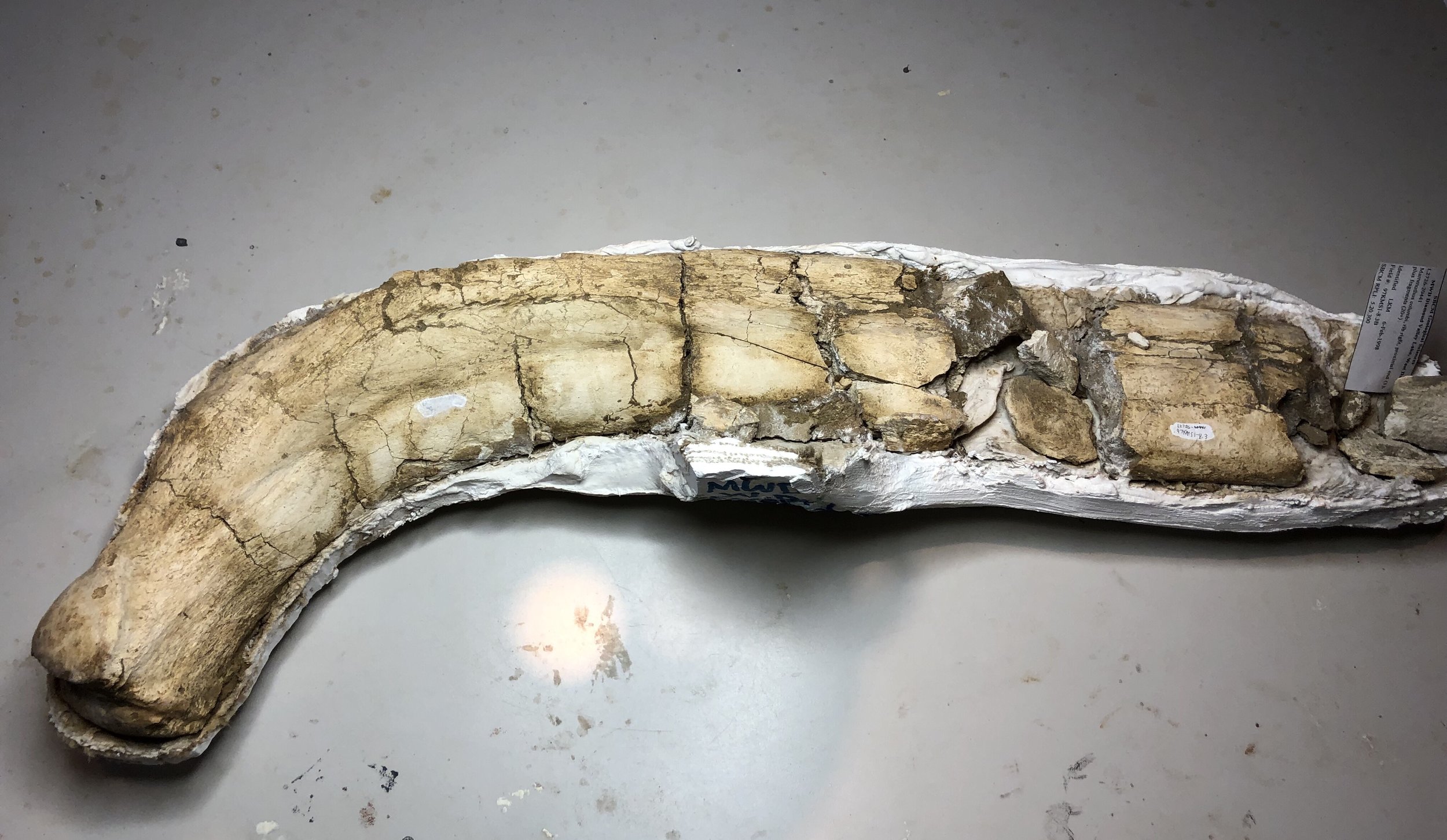 Organisms don't exist in a vacuum. The whole concept of an ecosystem emphasizes the interactions between an organism and its environment, including with other organisms. A large organism like a mammoth can have wide-ranging effects on numerous other organisms, even after its death.The specimen shown above is a partial Colombian mammoth rib from Diamond Valley Lake, currently being prepared by volunteer Tim Dooley. We have a large number of rib fragments such as this one, and at first glance they all look pretty much the same. But under close examination they often tell unique stories.After removing glue used to stabilize the specimen in the field, we realized this bone has a number of small, circular pits covering its surface:
Organisms don't exist in a vacuum. The whole concept of an ecosystem emphasizes the interactions between an organism and its environment, including with other organisms. A large organism like a mammoth can have wide-ranging effects on numerous other organisms, even after its death.The specimen shown above is a partial Colombian mammoth rib from Diamond Valley Lake, currently being prepared by volunteer Tim Dooley. We have a large number of rib fragments such as this one, and at first glance they all look pretty much the same. But under close examination they often tell unique stories.After removing glue used to stabilize the specimen in the field, we realized this bone has a number of small, circular pits covering its surface:
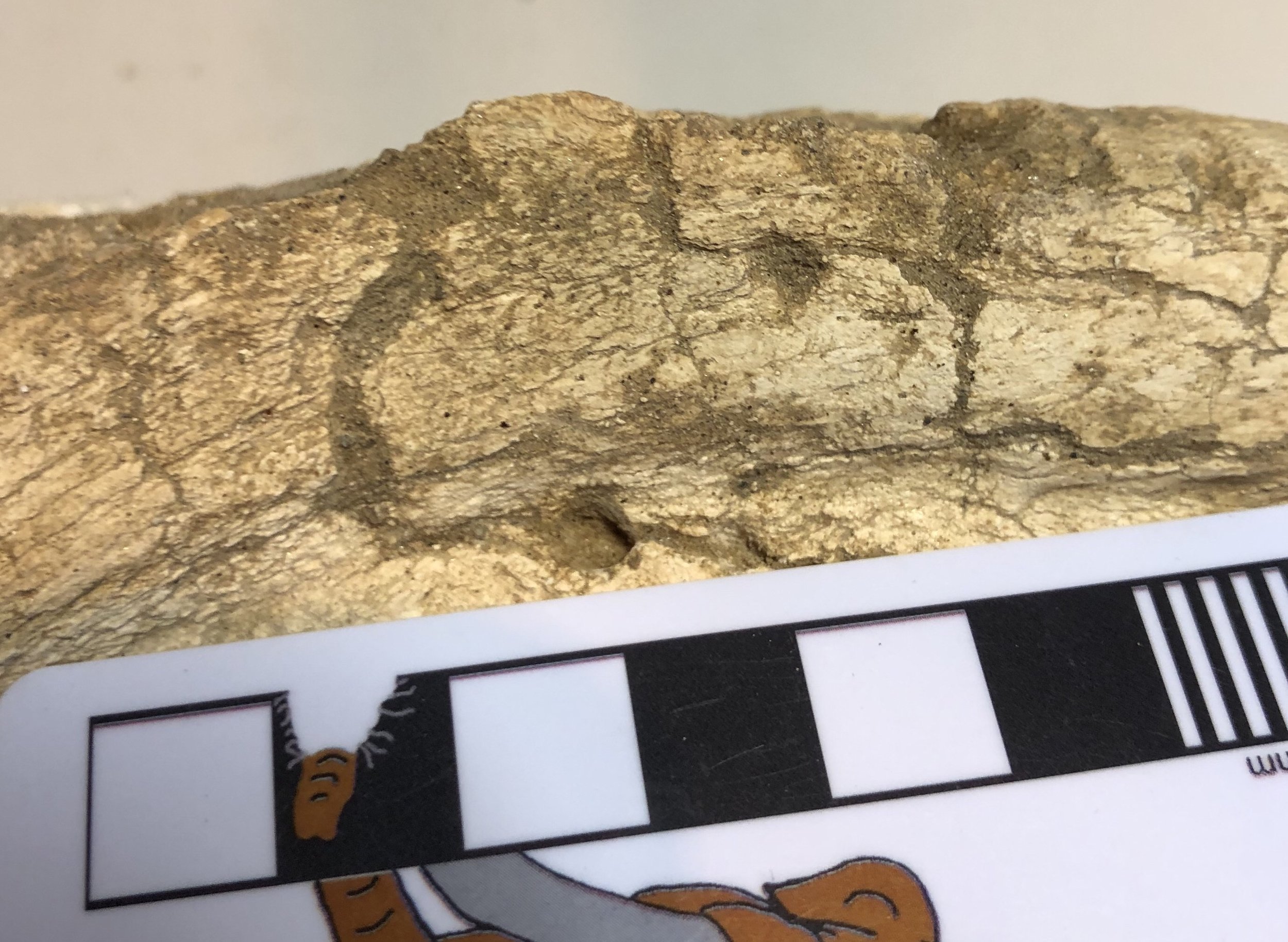
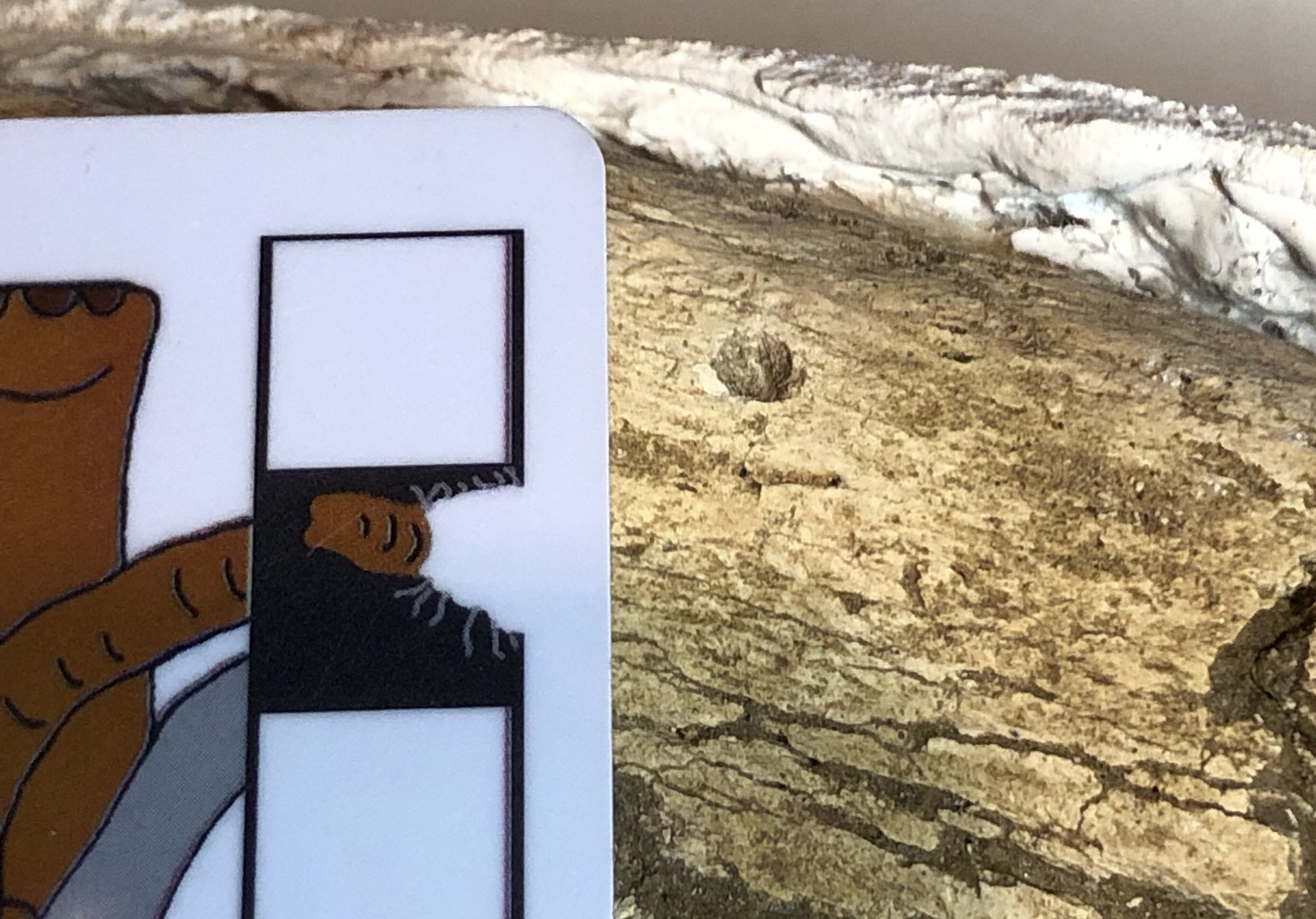 There are also some rough, pitted areas:
There are also some rough, pitted areas: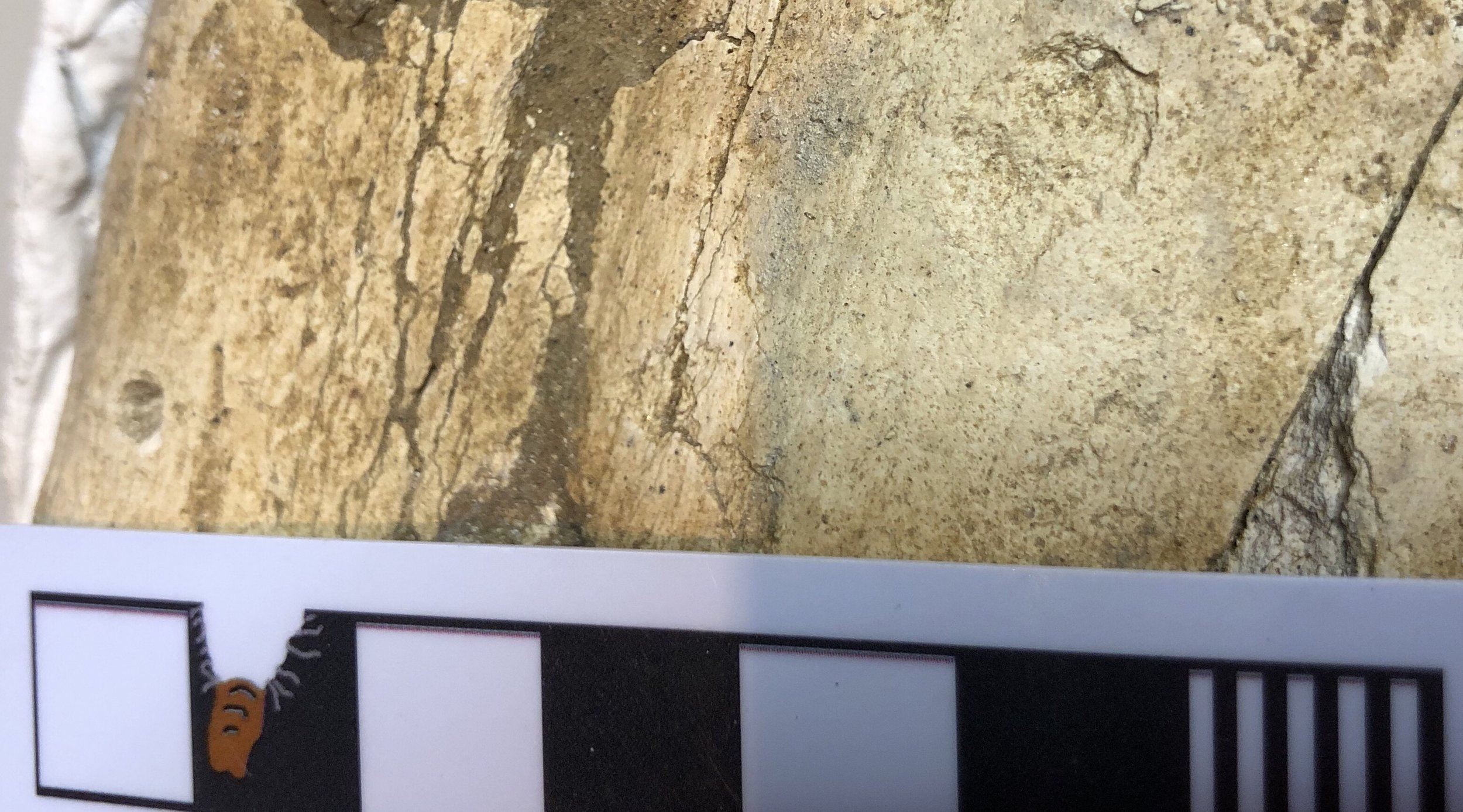 While I'm not 100% sure, I believe these are traces made by scavenging insects or other invertebrates, especially the rough patches in the last photo. I'm a little less certain of the circular holes. They are reminiscent of vertebrate bite marks, but they aren't paired and are tiny (all are less than 5 mm in diameter), so I think some sort of burrowing or bone-eating invertebrate is more likely.Marks such as these are quite common on DVL bones, and may eventually give us some insight into the invertebrate fauna from the valley, which left us almost no body fossils.
While I'm not 100% sure, I believe these are traces made by scavenging insects or other invertebrates, especially the rough patches in the last photo. I'm a little less certain of the circular holes. They are reminiscent of vertebrate bite marks, but they aren't paired and are tiny (all are less than 5 mm in diameter), so I think some sort of burrowing or bone-eating invertebrate is more likely.Marks such as these are quite common on DVL bones, and may eventually give us some insight into the invertebrate fauna from the valley, which left us almost no body fossils.
Fossil Friday - Camelops tooth
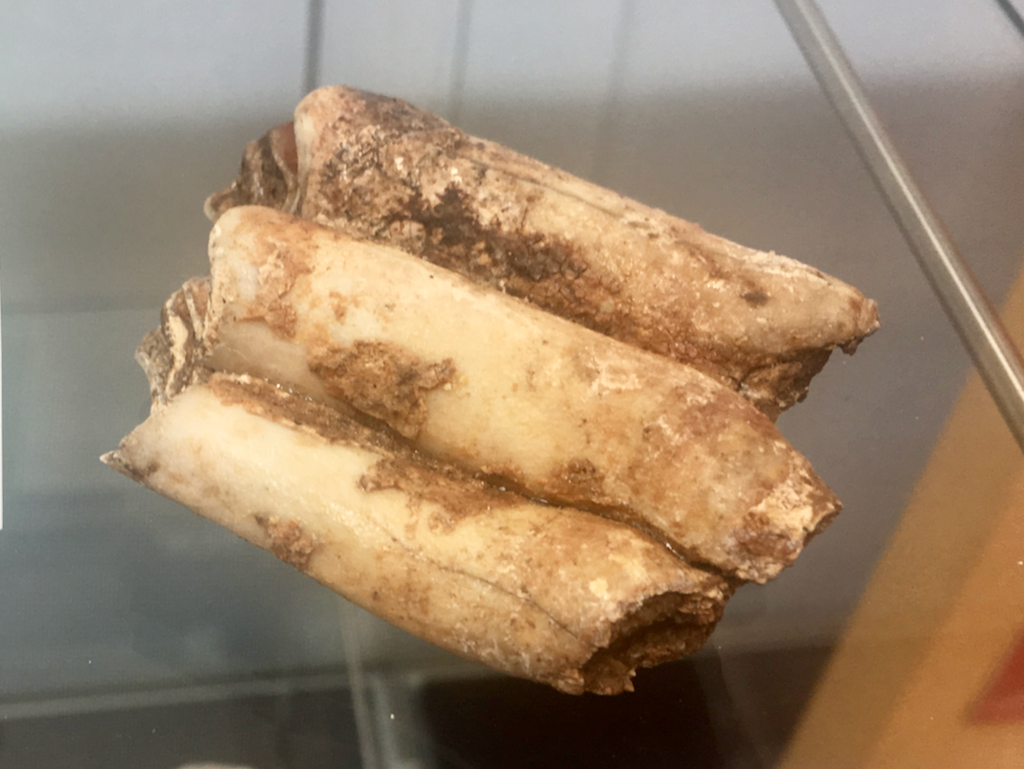 Today's Fossil Friday specimen comes from the Pleistocene camel Camelops hesternus, a taxon we've featured several times on this blog. But this specimen is special because of where it was found - in Joshua Tree National Park.Joshua Tree NP is best known for its eponymous trees and spectacular granite exposures, but the park also preserves delicate desert habitats, native cultural artifacts, and fossils. A few months ago Western Science Center became a repository for Joshua Tree, and dozens of vertebrate fossils collected under the direction of Kathleen Springer were transferred here. One of the specimens is the tooth shown here, a lower right third molar from Camelops.To the extent that dating these fossils has been possible, they are roughly equivalent in age to the Diamond Valley Lake and Rancho La Brea fossils. Yet there appear to be real faunal differences distinguishing Joshua Tree from other localities, and there is a lot of exciting research ahead for these fossils.Another thing in their future is an exhibit. WSC is opening a new temporary exhibit, "Fossils of Joshua Tree National Park", which will include representative fossils from this collection. There is an opening reception for museum members tonight, and the exhibit will open to the general public tomorrow morning. Thanks to Vincent Santucci from the National Park Service, Melanie Spoo and the staff of Joshua Tree National Park, and Kathleen Springer of the USGS for making WSC the fossil repository for Joshua Tree and making this exhibit possible.
Today's Fossil Friday specimen comes from the Pleistocene camel Camelops hesternus, a taxon we've featured several times on this blog. But this specimen is special because of where it was found - in Joshua Tree National Park.Joshua Tree NP is best known for its eponymous trees and spectacular granite exposures, but the park also preserves delicate desert habitats, native cultural artifacts, and fossils. A few months ago Western Science Center became a repository for Joshua Tree, and dozens of vertebrate fossils collected under the direction of Kathleen Springer were transferred here. One of the specimens is the tooth shown here, a lower right third molar from Camelops.To the extent that dating these fossils has been possible, they are roughly equivalent in age to the Diamond Valley Lake and Rancho La Brea fossils. Yet there appear to be real faunal differences distinguishing Joshua Tree from other localities, and there is a lot of exciting research ahead for these fossils.Another thing in their future is an exhibit. WSC is opening a new temporary exhibit, "Fossils of Joshua Tree National Park", which will include representative fossils from this collection. There is an opening reception for museum members tonight, and the exhibit will open to the general public tomorrow morning. Thanks to Vincent Santucci from the National Park Service, Melanie Spoo and the staff of Joshua Tree National Park, and Kathleen Springer of the USGS for making WSC the fossil repository for Joshua Tree and making this exhibit possible.
Fossil Friday - Miocene horses
Hello! I'm Brittney Stoneburg, the Marketing and Events Specialist for the Western Science Center. While my job mostly entails communications and outreach at the museum, I've spent the last year dipping my toes into research!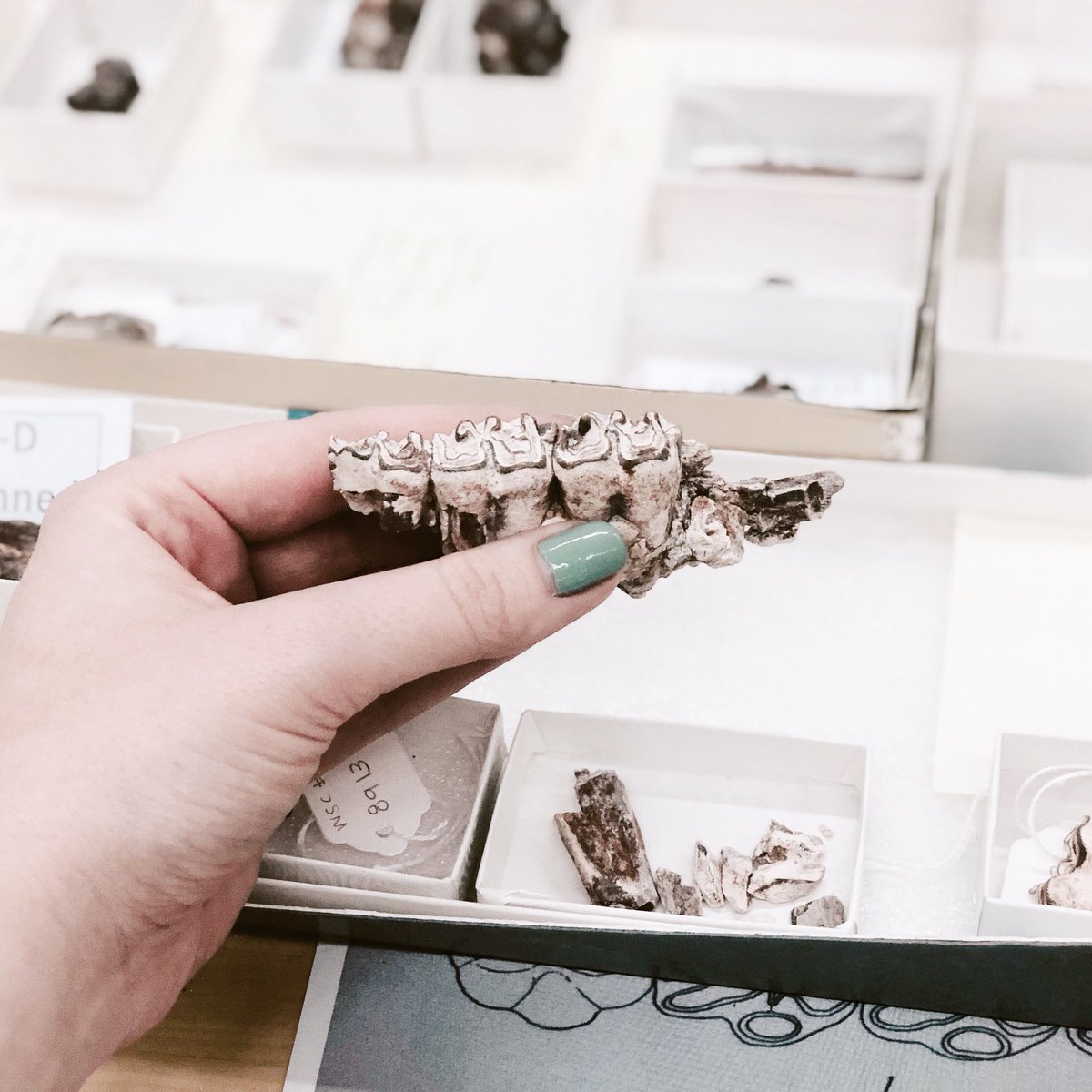 For my first research project, I've been working on fossils collected by the Western Science Center from our field site in San Bernardino National Forest. This means I'm up to my neck in horse teeth right now! I've been focusing on the small, three toed horses that roamed Southern California during the early to middle Miocene, approximately 18 million years ago.
For my first research project, I've been working on fossils collected by the Western Science Center from our field site in San Bernardino National Forest. This means I'm up to my neck in horse teeth right now! I've been focusing on the small, three toed horses that roamed Southern California during the early to middle Miocene, approximately 18 million years ago.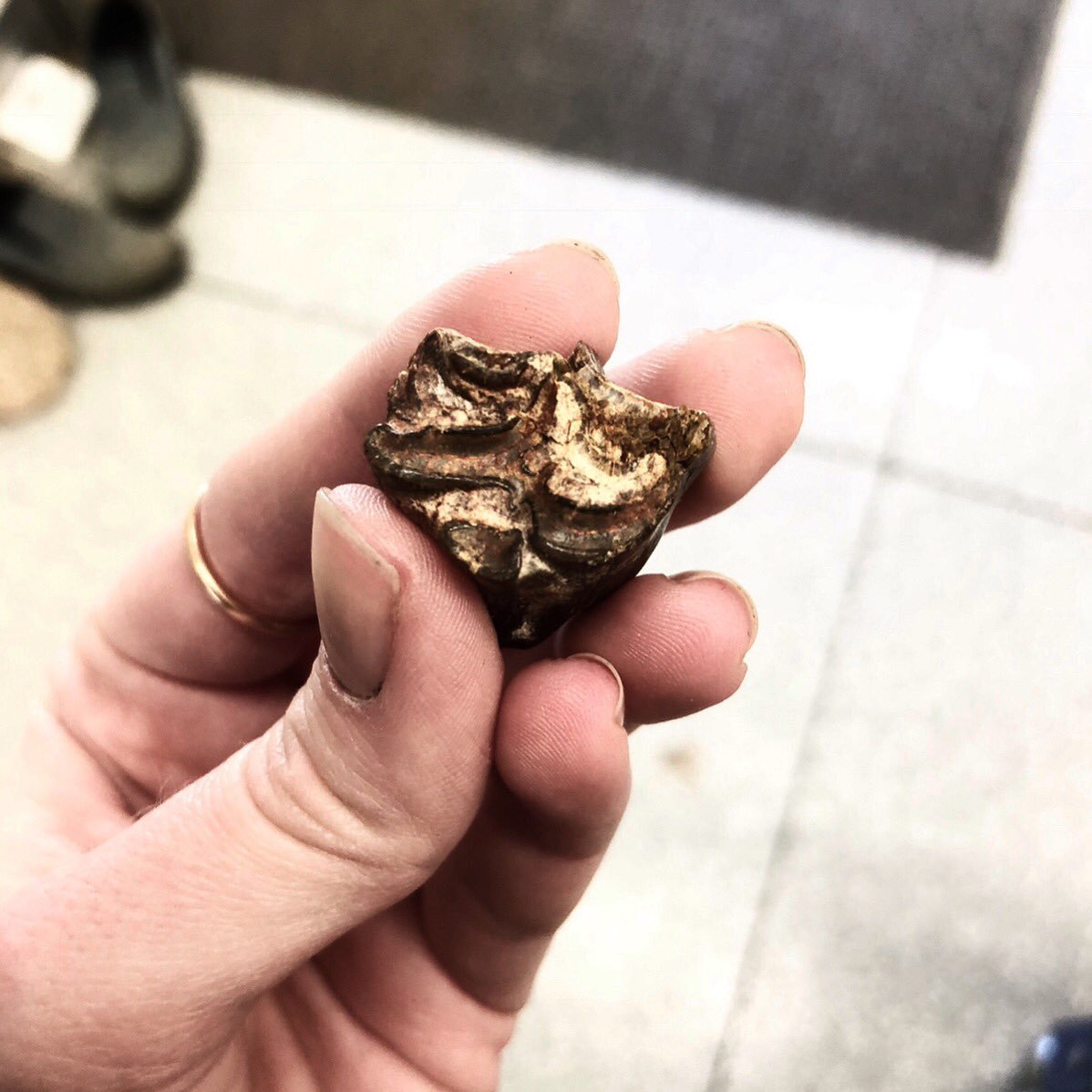 Multiple species of horse lived in this area, including Scaphohippus, whose teeth are picture above. While our collection from this site has only a few post-cranial bits, we can make pretty solid identifications just from the teeth. Horse teeth like these have numerous features that make it possible to identify them down to the species level. Knowing what horses lived in this area during the Miocene can tell us a lot not only about the horses themselves, but about the environment they lived in!I'll be presenting on my research at the North American Paleontological Conference in June, so if you'll be there, feel free to ask me about all of these horses!
Multiple species of horse lived in this area, including Scaphohippus, whose teeth are picture above. While our collection from this site has only a few post-cranial bits, we can make pretty solid identifications just from the teeth. Horse teeth like these have numerous features that make it possible to identify them down to the species level. Knowing what horses lived in this area during the Miocene can tell us a lot not only about the horses themselves, but about the environment they lived in!I'll be presenting on my research at the North American Paleontological Conference in June, so if you'll be there, feel free to ask me about all of these horses!
Fossil Friday - ceratopsid illium
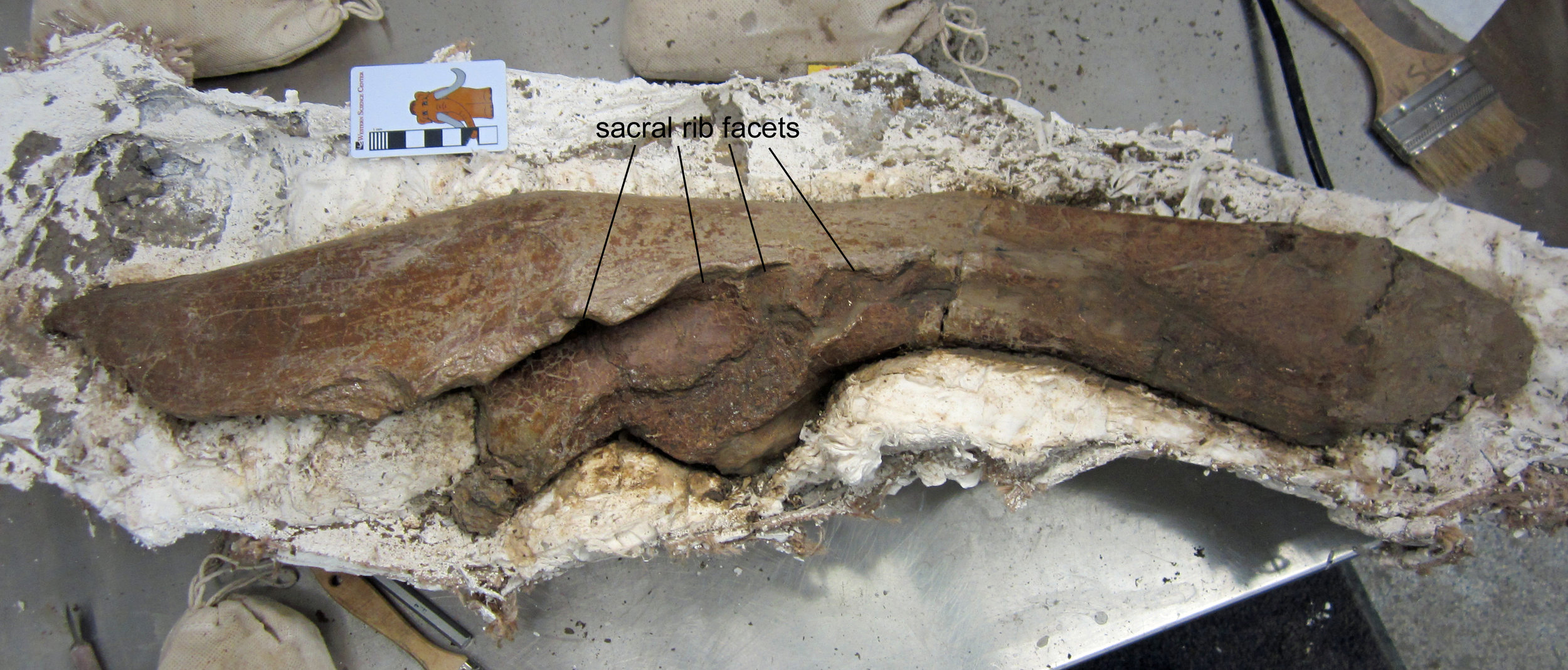 Last week for Fossil Friday, I posted the sacrum of a ceratopsid, a large horned dinosaur related to Triceratops. The sacrum is a series of fused vertebrae to which the hip bones attach. Today, I want to show you one of those hip bones from the same ceratopsid individual. This is the left ilium, showing the inner surface where it would have attached to the sacral ribs along a series of deep facets. At about 80 centimeters long, this ilium is not terribly big for a ceratopsid, but it still would have been a hefty animal, plodding around the forests and swamps of Late Cretaceous New Mexico.In the coming months, we will create 3D-printed replicas of the sacrum and ilium of this ceratopsid to see how they fit together, the first step in rebuilding this 79-million-year-old skeleton. We also have several vertebrae and ribs from the back. This specimen was collected during the 2017 and 2018 field seasons by staff and volunteers from the Western Science Center, Zuni Dinosaur Institute for Geosciences, and Southwest Paleontological Society. The sacrum and ilium have both been prepped by WSC lab volunteer Joe Reavis.Post by Curator Dr. Andrew McDonald.
Last week for Fossil Friday, I posted the sacrum of a ceratopsid, a large horned dinosaur related to Triceratops. The sacrum is a series of fused vertebrae to which the hip bones attach. Today, I want to show you one of those hip bones from the same ceratopsid individual. This is the left ilium, showing the inner surface where it would have attached to the sacral ribs along a series of deep facets. At about 80 centimeters long, this ilium is not terribly big for a ceratopsid, but it still would have been a hefty animal, plodding around the forests and swamps of Late Cretaceous New Mexico.In the coming months, we will create 3D-printed replicas of the sacrum and ilium of this ceratopsid to see how they fit together, the first step in rebuilding this 79-million-year-old skeleton. We also have several vertebrae and ribs from the back. This specimen was collected during the 2017 and 2018 field seasons by staff and volunteers from the Western Science Center, Zuni Dinosaur Institute for Geosciences, and Southwest Paleontological Society. The sacrum and ilium have both been prepped by WSC lab volunteer Joe Reavis.Post by Curator Dr. Andrew McDonald.
Fossil Friday - ceratopsian sacrum
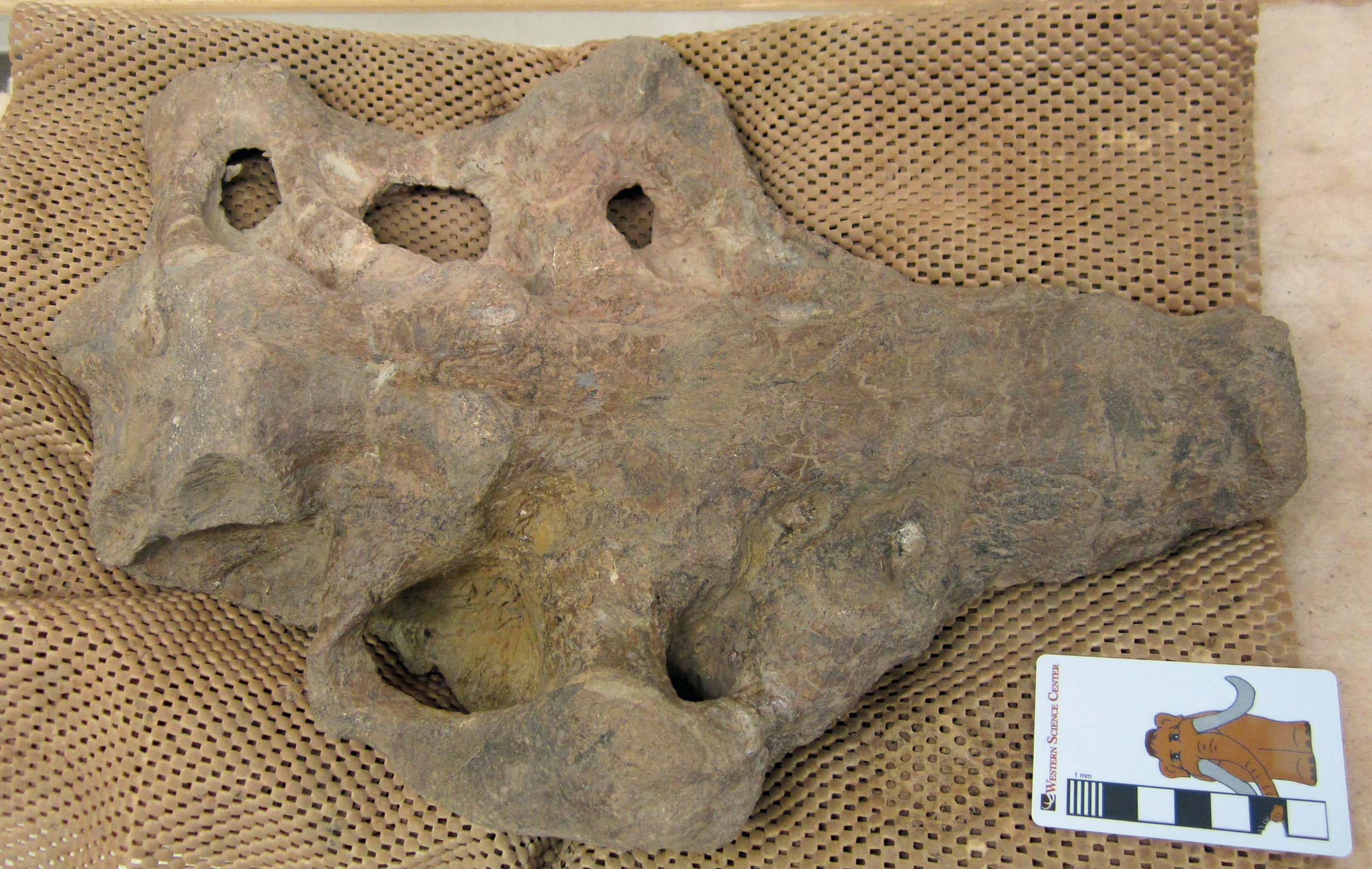 Horned dinosaurs were one of the most successful groups of dinosaurs in the Late Cretaceous of western North America. Known as ceratopsids, these rhino- to elephant-sized beasts brandished horns, spikes, and frills on their massive skulls. More than 40 different species are known to have inhabited western North America at different points in time between 80 and 66 million years ago. The last of them was the great "three-horned face" - Triceratops.Ceratopsids have been known from the Menefee Formation of New Mexico since the 1990s, when paleontologists at the New Mexico Museum of Natural History & Science reported fossils including a partial skeleton. More recent expeditions to the Menefee by the Western Science Center, Zuni Dinosaur Institute for Geosciences, and Southwest Paleontological Society have discovered further ceratopsid fossils, including another partial skeleton now being prepped at WSC.Today's image is the sacrum of that 79-million-year-old ceratopsid skeleton, recently prepped by WSC volunteer Joe Reavis. The sacrum is a series of fused vertebrae to which the hips were attached. In the image, the bottom surface of the bone is visible. We'll be working on more bones from this skeleton over the coming months, including a hip bone, more vertebrae, and ribs.Post by Curator Dr. Andrew McDonald.
Horned dinosaurs were one of the most successful groups of dinosaurs in the Late Cretaceous of western North America. Known as ceratopsids, these rhino- to elephant-sized beasts brandished horns, spikes, and frills on their massive skulls. More than 40 different species are known to have inhabited western North America at different points in time between 80 and 66 million years ago. The last of them was the great "three-horned face" - Triceratops.Ceratopsids have been known from the Menefee Formation of New Mexico since the 1990s, when paleontologists at the New Mexico Museum of Natural History & Science reported fossils including a partial skeleton. More recent expeditions to the Menefee by the Western Science Center, Zuni Dinosaur Institute for Geosciences, and Southwest Paleontological Society have discovered further ceratopsid fossils, including another partial skeleton now being prepped at WSC.Today's image is the sacrum of that 79-million-year-old ceratopsid skeleton, recently prepped by WSC volunteer Joe Reavis. The sacrum is a series of fused vertebrae to which the hips were attached. In the image, the bottom surface of the bone is visible. We'll be working on more bones from this skeleton over the coming months, including a hip bone, more vertebrae, and ribs.Post by Curator Dr. Andrew McDonald.
Fossil Friday - fern
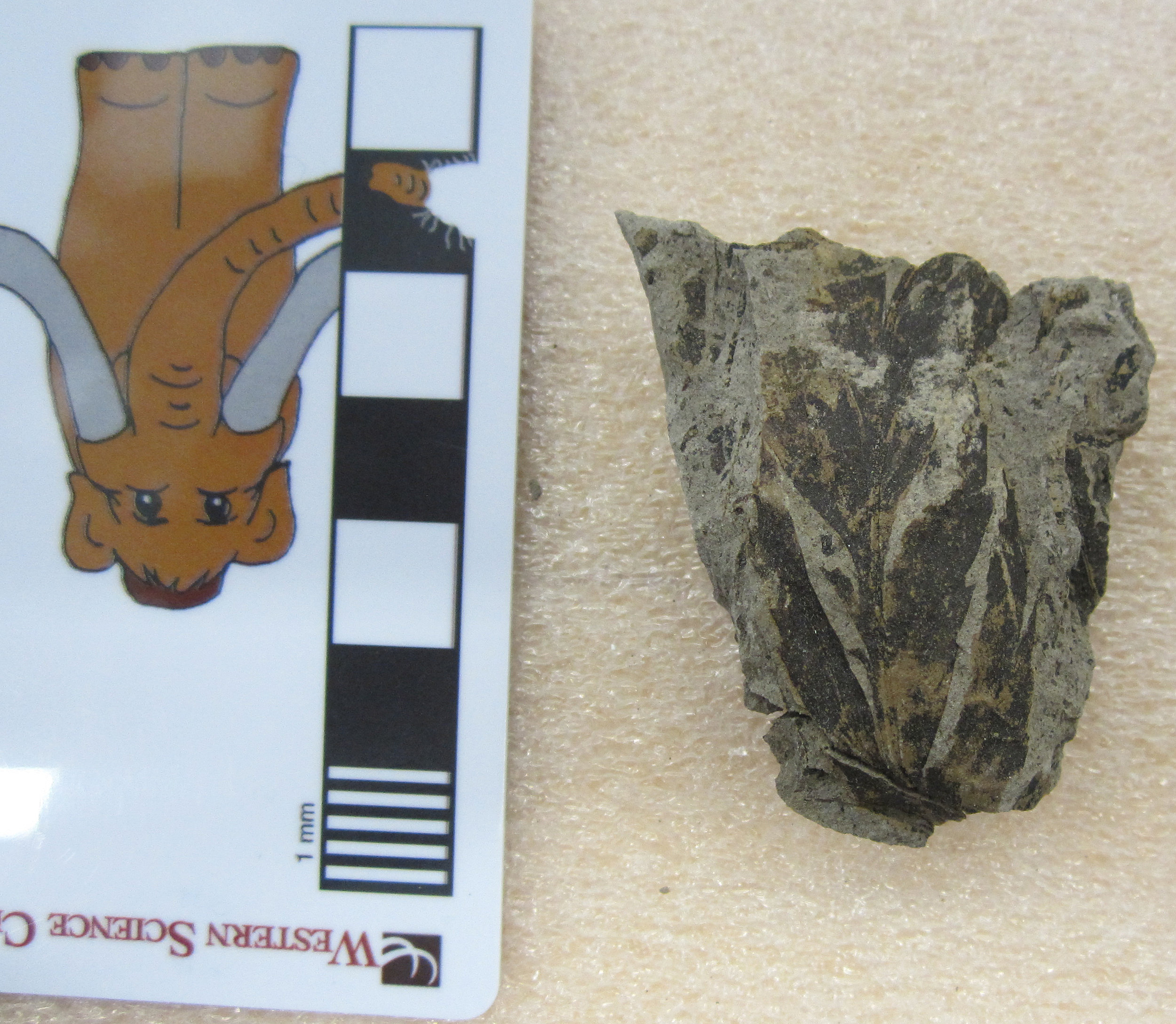 Over the last year or so, I've posted many bones from large herbivorous dinosaurs that lived in New Mexico around 79 million years ago, such as duck-billed hadrosaurs, horned ceratopsids, and the armored Invictarx.Alongside the bones of these beasts in the Menefee Formation we often find fossil plants. Many of these occurrences are petrified logs and stumps, which we find eroding out onto the surface.However, sometimes when we dig into the layers of mudstone to excavate dinosaur bones, we also encounter beautiful fossil leaves. The image today is a very nice leaf from a Late Cretaceous fern, probably belonging to the living fern genus Anemia. Fossils like this give us some idea of what the plant-eating dinosaurs might have been eating, and show that back then New Mexico was a much wetter habitat than today. It was a muddy floodplain lush with plants and teeming with dinosaurs.Post by Curator Dr. Andrew McDonald
Over the last year or so, I've posted many bones from large herbivorous dinosaurs that lived in New Mexico around 79 million years ago, such as duck-billed hadrosaurs, horned ceratopsids, and the armored Invictarx.Alongside the bones of these beasts in the Menefee Formation we often find fossil plants. Many of these occurrences are petrified logs and stumps, which we find eroding out onto the surface.However, sometimes when we dig into the layers of mudstone to excavate dinosaur bones, we also encounter beautiful fossil leaves. The image today is a very nice leaf from a Late Cretaceous fern, probably belonging to the living fern genus Anemia. Fossils like this give us some idea of what the plant-eating dinosaurs might have been eating, and show that back then New Mexico was a much wetter habitat than today. It was a muddy floodplain lush with plants and teeming with dinosaurs.Post by Curator Dr. Andrew McDonald
Fossil Friday - Mistaken Identity
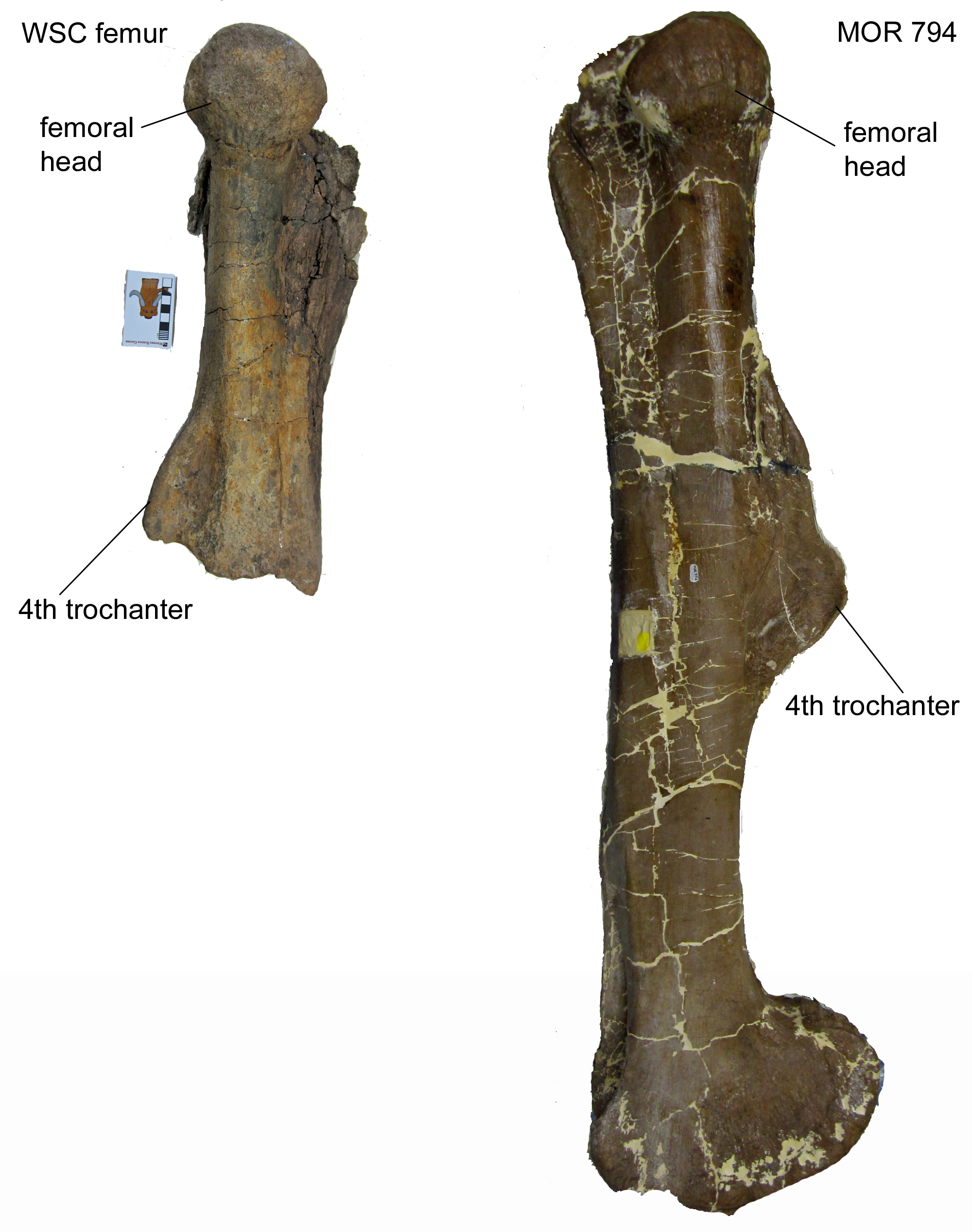 On March 8 Fossil Friday, I posted an 80-million-year-old dinosaur bone from New Mexico, which I identified as a tibia (shin bone). At the time, it was only partially prepped, and since then, WSC volunteer Joe Reavis has been working tirelessly to remove the remaining mudstone.It turns out the "tibia" is actually a femur! It's the proximal half of the left femur of a hadrosaur, one of the large duck-billed plant-eating dinosaurs that are so abundant in Upper Cretaceous rocks throughout the American West. Comparison with a complete hadrosaur femur from Montana (Museum of the Rockies specimen MOR 794) allows us to identify several major features, including the head that fitted into the hip socket and the 4th trochanter, a major muscle attachment site. It also shows that the WSC femur is from a fairly large individual, probably close to 30 feet long.Hadrosaur bones are very common in the Menefee Formation, the rock layer in which this femur was collected by my colleagues from the Zuni Dinosaur Institute for Geosciences and Southwest Paleontological Society in 2015. We'll have more to say in the near future.Post by Curator Dr. Andrew McDonald
On March 8 Fossil Friday, I posted an 80-million-year-old dinosaur bone from New Mexico, which I identified as a tibia (shin bone). At the time, it was only partially prepped, and since then, WSC volunteer Joe Reavis has been working tirelessly to remove the remaining mudstone.It turns out the "tibia" is actually a femur! It's the proximal half of the left femur of a hadrosaur, one of the large duck-billed plant-eating dinosaurs that are so abundant in Upper Cretaceous rocks throughout the American West. Comparison with a complete hadrosaur femur from Montana (Museum of the Rockies specimen MOR 794) allows us to identify several major features, including the head that fitted into the hip socket and the 4th trochanter, a major muscle attachment site. It also shows that the WSC femur is from a fairly large individual, probably close to 30 feet long.Hadrosaur bones are very common in the Menefee Formation, the rock layer in which this femur was collected by my colleagues from the Zuni Dinosaur Institute for Geosciences and Southwest Paleontological Society in 2015. We'll have more to say in the near future.Post by Curator Dr. Andrew McDonald
Fossil Friday - Paralia sulcata
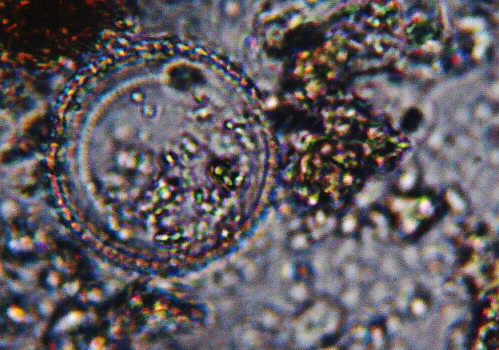 "Max's Minions" is the informal name for WSC's junior research volunteer program. The Minions perform a variety of lab duties for us, including 3D scanning, molding and casting, skinning carcasses for our dermestid colony, preparing fossils, and other tasks. Several of them are also working on their own research projects.Western Center Academy student Sianna Xiao has been pulling sediment samples off our small collection of fossil bones and shells from Neogene deposits in Virginia. Using a protocol developed some years ago by one of my former student interns, Anna Trochim, she has been preparing those samples for studying their diatoms.Diatoms are single-celled eukaryotic algae that live in the water. An important characteristic of diatoms for paleontologists is that they secrete a cell wall (called a frustule) that is made of silicon dioxide; essentially, they have glass shells. This means that they preserve well as fossils.Diatoms are one of the main things we use to determine environmental conditions, as various species may be sensitive to changes in salinity, temperature, pH, or other factors. Since they are photosynthetic, they depend on sunlight, so forms that live on the seafloor can only live in shallow water (less than 100 m, and usually less than 20 m). They are also one of the main organisms used in Cenozoic marine biostratigraphy, meaning they are important for determining the age of marine deposits. So there is an abundance of reasons to study diatoms.One of Sianna's samples comes from the Miocene Calvert Formation at the Carmel Church Quarry. Anna and I published the Carmel Church diatom flora a few years ago, but since we know it contains diatoms it's a good way to learn the sample protocol and practice identifications. The image above is one of the most common species at Carmel Church, Paralia sulcata. As expected, it's one of the most common in Sianna's slides as well. This species, while common, has a tremendous temporal range m(from the Cretaceous to Recent), so it's of no biostratigraphic value. It also can live in seawater ranging from brackish to normal salinity, and also lives in a variety of environments, so it doesn't actually tell us a whole lot about the age or paleoenvironment. But 27 other species are known from Carmel Church so far, so there will be plenty more to see.
"Max's Minions" is the informal name for WSC's junior research volunteer program. The Minions perform a variety of lab duties for us, including 3D scanning, molding and casting, skinning carcasses for our dermestid colony, preparing fossils, and other tasks. Several of them are also working on their own research projects.Western Center Academy student Sianna Xiao has been pulling sediment samples off our small collection of fossil bones and shells from Neogene deposits in Virginia. Using a protocol developed some years ago by one of my former student interns, Anna Trochim, she has been preparing those samples for studying their diatoms.Diatoms are single-celled eukaryotic algae that live in the water. An important characteristic of diatoms for paleontologists is that they secrete a cell wall (called a frustule) that is made of silicon dioxide; essentially, they have glass shells. This means that they preserve well as fossils.Diatoms are one of the main things we use to determine environmental conditions, as various species may be sensitive to changes in salinity, temperature, pH, or other factors. Since they are photosynthetic, they depend on sunlight, so forms that live on the seafloor can only live in shallow water (less than 100 m, and usually less than 20 m). They are also one of the main organisms used in Cenozoic marine biostratigraphy, meaning they are important for determining the age of marine deposits. So there is an abundance of reasons to study diatoms.One of Sianna's samples comes from the Miocene Calvert Formation at the Carmel Church Quarry. Anna and I published the Carmel Church diatom flora a few years ago, but since we know it contains diatoms it's a good way to learn the sample protocol and practice identifications. The image above is one of the most common species at Carmel Church, Paralia sulcata. As expected, it's one of the most common in Sianna's slides as well. This species, while common, has a tremendous temporal range m(from the Cretaceous to Recent), so it's of no biostratigraphic value. It also can live in seawater ranging from brackish to normal salinity, and also lives in a variety of environments, so it doesn't actually tell us a whole lot about the age or paleoenvironment. But 27 other species are known from Carmel Church so far, so there will be plenty more to see.
Fossil Friday - abelone
 Last week Cogstone Resource Management (http://www.cogstone.com) delivered a collection of Pleistocene deposits from Ventura County to the Western Science Center. This included a number of both vertebrate and invertebrate fossils.These photos show a shell from an abelone, Haliotis sp.. While the shell looks a lot like a clam, abelone are actually snails; the light-colored early whirls of the shell are visible adjacent to the scale bar. It's also clear on the other side of the shell that it's not from a clam, as there is no hinge line to articulate with a second shell (below). This view also shows off the opalescence for which abelone are famous.
Last week Cogstone Resource Management (http://www.cogstone.com) delivered a collection of Pleistocene deposits from Ventura County to the Western Science Center. This included a number of both vertebrate and invertebrate fossils.These photos show a shell from an abelone, Haliotis sp.. While the shell looks a lot like a clam, abelone are actually snails; the light-colored early whirls of the shell are visible adjacent to the scale bar. It's also clear on the other side of the shell that it's not from a clam, as there is no hinge line to articulate with a second shell (below). This view also shows off the opalescence for which abelone are famous. Abelone typically live in fairly shallow water just below the intertidal zone, where they feed on algae. Associated fossils in this collection also indicate a similar shallow marine setting.This abelone and other fossils from this site will be featured in an exhibit opening at WSC this fall. Thanks to Cogstone for bringing it to us!
Abelone typically live in fairly shallow water just below the intertidal zone, where they feed on algae. Associated fossils in this collection also indicate a similar shallow marine setting.This abelone and other fossils from this site will be featured in an exhibit opening at WSC this fall. Thanks to Cogstone for bringing it to us!











